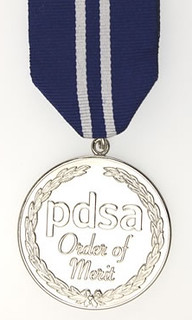
About UsThe Numismatic Bibliomania Society is a non-profit association devoted to the study and enjoyment of numismatic literature. For more information please see our web site at coinbooks.org SubscriptionsThose wishing to become new E-Sylum subscribers (or wishing to Unsubscribe) can go to the following web page link MembershipThere is a membership application available on the web site Membership Application To join, print the application and return it with your check to the address printed on the application. Print/Digital membership is $40 to addresses in the U.S., and $60 elsewhere. A digital-only membership is available for $25. For those without web access, write to: Charles Heck, Treasurer AsylumFor Asylum mailing address changes and other membership questions, contact Terry at this email address: terrywhite5475@yahoo.com SubmissionsTo submit items for publication in The E-Sylum, write to the Editor at this address: whomren@gmail.com
BUY THE BOOK BEFORE THE COIN |
- WAYNE'S WORDS: THE E-SYLUM MARCH 31, 2019
- NEW NBS TREASURER CHUCK HECK
- KOLBE & FANNING SALE 152 ANNOUNCED
- BOOKMAKING: PLEASURE AND PROFIT
- NEW BOOK: NUMISMATICS AND AI
- BOOK REVIEW: CITY OF DEVILS
- NUMISMATIQUE ASIATIQUE DECEMBER 2018 PUBLISHED
- COIN BOARD NEWS 50TH ISSUE PUBLISHED
- 2019 ANA OUTSTANDING CLUB PUBLICATIONS
- EARLY AMERICAN MEDALS FROM NECESSITY TO GHENT
- VIDEO: SELBY UNGAR MEMORIAL
- HUNGARIAN MUSEUM WASS, MOLITOR EXHIBIT
- MODERN U.S. COINAGE MINTAGE ANSWERS
- THE TAD COLLECTION
- NOTES FROM E-SYLUM READERS: MARCH 31, 2019
- MORE ON THE FIP AND FIPPENNY BIT
- FIRST ELECTRONIC MONEY IDENTIFIER FOR THE BLIND
- VOCABULARY TERMS: SERIES
- GEORGE WILLIAM RODE (1858-1904)
- CHICAGO INDUCTS VIRGIL BRAND INTO HALL OF FAME
- VIRGIL BRAND ON THE OBJECTS OF COLLECTING
- BOWERS: JOURNAL OF EARLY AMERICAN NUMISMATICS
- HISTORY OF THE KOINPANEL
- 1794 DOLLAR, 1894-S DIME REPORTED STOLEN
- THE FOGG MUSEUM COIN HEIST
- ROMAN MILITARY PAY
- SELINA MARTIN SUFFRAGETTE HUNGER STRIKE MEDAL
- LONDON BRIDGE DOGS WIN PDSA ORDER OF MERIT
- CANADA'S VERTICAL NOTE THAT ALMOST WAS
- IS CRYPTOCURRENCY REALLY A NEW IDEA?
- THE VIRGINIA CITY PONDEROSA SALOON
- LOOSE CHANGE: MARCH 31, 2019
Click here to access the complete archive a
Click here to unsubscribe (scroll down)
To comment or submit articles, reply to whomren@gmail.com
Content presented in The E-Sylum is not necessarily researched or independently fact-checked, and views expressed do not necessarily represent those of the Numismatic Bibliomania Society.
WAYNE'S WORDS: THE E-SYLUM MARCH 31, 2019
 New subscribers this week include:
Prakash Chandra Behera, Jen Benson, Eric Jackson, and Jean Paul. Welcome aboard! We now have 5,908 subscribers.
New subscribers this week include:
Prakash Chandra Behera, Jen Benson, Eric Jackson, and Jean Paul. Welcome aboard! We now have 5,908 subscribers.
Thank you for reading The E-Sylum. If you enjoy it, please send me the email addresses of friends you think may enjoy it as well and I'll send them a subscription (but let me know if they are located in the European Union). Contact me at whomren@gmail.com anytime regarding your subscription, or questions, comments or suggestions about our content.
This week we open with an update from our sponsor organization, a numismatic literature sale announcement, an overview of Bob Shippee's Pleasure and Profit, one new book, one review and two periodicals.
Other topics this week include early American medals, the Hungarian National Museum's U.S. coin exhibit, some modern U.S. coinage mintage figures, the TAD collection of large cents, collector Virgil Brand, the Koinpanel, the Fogg Museum coin heist, suffragette hunger strike medals, and the PDSA Order of Merit for hero animals.
To learn more about numismatics and Artificial Intelligence, Shanghai gambling club tokens, the King of Carson City Silver Dollars, centenarian numismatists, the first electronic money identifier for the blind, ANA Charter Member No. 12, a stolen 1894-S dime, Roman military pay, and the vertical banknote that almost was, read on. Have a great week, everyone!
Wayne Homren
Editor, The E-Sylum
NEW NBS TREASURER CHUCK HECK
The Numismatic Bibliomania Society has a new Treasurer. Please welcome Chuck Heck! -Editor
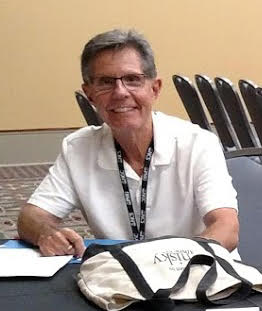 Please welcome our new NBS Treasurer Chuck Heck! We are so grateful to Chuck for making our new 501(c)(3) tax-deductible status possible and for taking over as Treasurer. Chuck can be reached at treasurer@coinbooks.org and at the address below, as well as all membership dues.
Please welcome our new NBS Treasurer Chuck Heck! We are so grateful to Chuck for making our new 501(c)(3) tax-deductible status possible and for taking over as Treasurer. Chuck can be reached at treasurer@coinbooks.org and at the address below, as well as all membership dues.
Numismatic Bibliomania Society
Chuck Heck, Treasurer
P.O. Box 2058
Bluffton, SC 29910-2058
A big thanks also goes out to outgoing treasurer Terry White for his help over the years.
For more information on our society, see:
https://coinbooks.org/

KOLBE & FANNING SALE 152 ANNOUNCED
Kolbe & Fanning's next numismatic literature sale will close April 27, 2019. Here's the announcement. -Editor
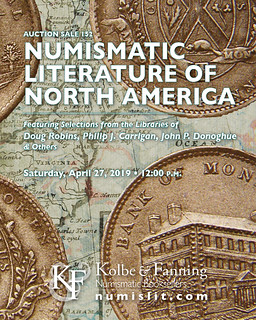 Kolbe & Fanning Numismatic Booksellers are announcing our Sale 152, which will be held on Saturday, April 27, 2019. The 441-lot sale is entirely devoted to North American numismatics (though a number of important catalogues issued by American dealers offering ancient and foreign coins are also included). Material from the libraries of Doug Robins, Philip J. Carrigan and John P. Donoghue are featured, as are special offerings from the libraries of Reed Hawn, Del Bland and Q. David Bowers. The sale will be of particular interest to collectors of Canadian coins, medals, tokens and paper money.
Kolbe & Fanning Numismatic Booksellers are announcing our Sale 152, which will be held on Saturday, April 27, 2019. The 441-lot sale is entirely devoted to North American numismatics (though a number of important catalogues issued by American dealers offering ancient and foreign coins are also included). Material from the libraries of Doug Robins, Philip J. Carrigan and John P. Donoghue are featured, as are special offerings from the libraries of Reed Hawn, Del Bland and Q. David Bowers. The sale will be of particular interest to collectors of Canadian coins, medals, tokens and paper money.
Some highlights of the sale include:
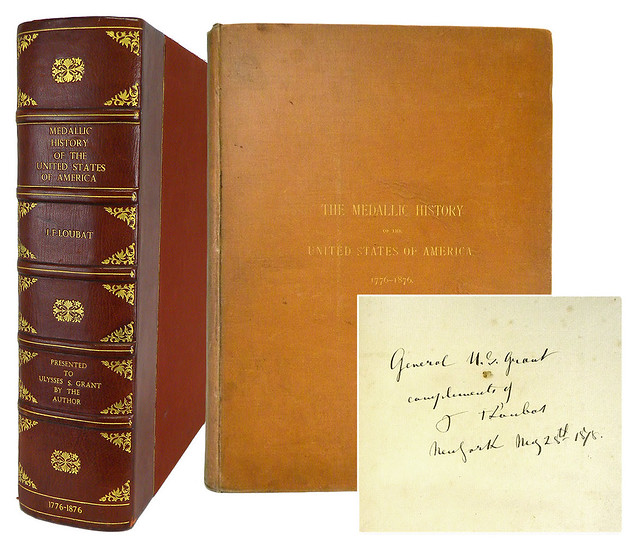
Lot 263
Lot 263: President Ulysses S. Grant's set of Loubat's Medallic History of the United States of America, presented by the author to the subject of two of the medals described and depicted therein
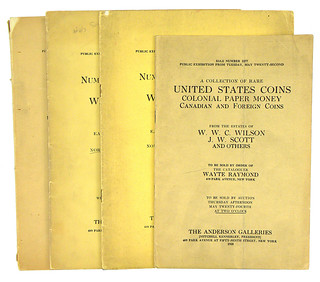
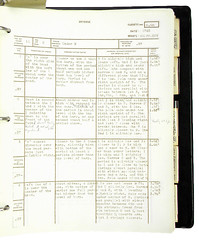
Lots 324 and 411
Lot 324: all four of Wayte Raymond's W.W.C. Wilson sales, including the rare fourth sale (1928)
Lot 411: an unpublished work on the William Wood coinage, written by Robert Vlack and Philip Keller and annotated by Walter Breen.
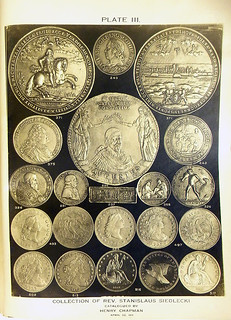
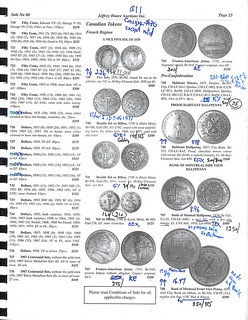
Lots 111 and 217
Lot 111: an attractive copy of the 1911 Stanislaus Siedlecki catalogue with photographic plates, part of a consignment from legendary collector Reed Hawn featuring nearly every large-format plated Chapman catalogue
Lot 217: over 100 Jeffrey Hoare sale catalogues, many being Doug and Rita Robins's annotated saleroom copies
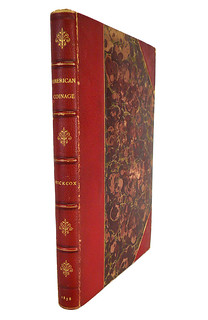
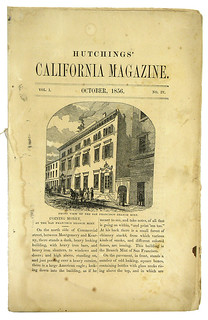
Lots 214 and 228
Lot 214: a handsome copy of Hickcox's 1858 Historical Account of American Coinage
Lot 228: James Hutchings's illustrated 1856 account of the San Francisco Mint
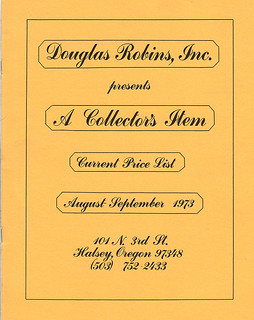
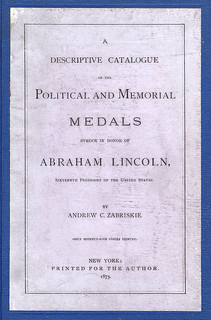
Lots 341 and 439
Lot 341: a set of Doug Robins's fixed price list, A Collector's Item, from his own library
Lot 439: Andrew Zabriskie's rare 1873 catalogue of medals honoring Abraham Lincoln
The printed catalogue of Sale 152 will be mailed to active customers in the near future. A PDF of the printed catalogue has been posted to our main website at numislit.com for those who prefer that format. Bids placed via post, email, fax or phone must be received by Friday, April 26, the day before the sale, in order for them to be processed. Advance absentee bids may also be placed at any time online at bid.numislit.com; live internet bidding will be available during the sale itself through the same platform.
Kolbe & Fanning Numismatic Booksellers LLC is a licensed and bonded auction firm in the State of Ohio. For more information, please see the Kolbe & Fanning website at bid.numislit.com or email David Fanning at df@numislit.com.

BOOKMAKING: PLEASURE AND PROFIT
Dennis Tucker of Whitman Publishing submitted these thoughts on Bob Shippee's great book Pleasure and Profit. Thanks. -Editor
Pleasure and Profit: The Hobby and the Market are Two Sides of the Same Coin for Collector Bob Shippee
by Dennis Tucker
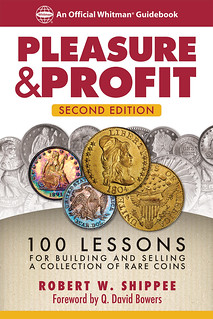 Robert W. Shippee's book Pleasure and Profit: 100 Lessons for Building and Selling a Collection of Rare Coins was unique in numismatic publishing when it debuted in November 2014.
Now in its second edition, it remains unique today—an insightful guide to building a coin collection, intelligently.
Robert W. Shippee's book Pleasure and Profit: 100 Lessons for Building and Selling a Collection of Rare Coins was unique in numismatic publishing when it debuted in November 2014.
Now in its second edition, it remains unique today—an insightful guide to building a coin collection, intelligently.
What makes Pleasure and Profit so unusual? Shippee tells his story “warts and all," publicly sharing not only his very profitable purchases, but also the expensive mistakes, with valuable lessons learned from each. His tale is crowned by a successful $1.5 million auction.
Collectors new and old loved the first edition. Pleasure and Profit quickly became one of the most discussed books on collecting and investing in Whitman Publishing's numismatic lineup. Shippee was invited to build an educational course around it. He and Kenneth Bressett (longtime editor of the Guide Book of United States Coins) taught the class at the American Numismatic Association's 2015 Summer Seminar. Another indicator of a book's popularity is how frequently it gets mentioned in related conversations. I've been happy to read so many positive comments and unsolicited recommendations in the hobby press, in book reviews, and in online bulletin boards.

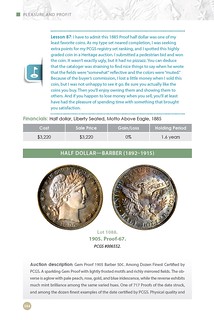
Over the course of my publishing career I've read hundreds of numismatic guidebooks, references, encyclopedias, and catalogs. Not just browsed them, not just looked at their pictures, but actually read them, word for word, from the title page to the last index entry. It was wonderful to watch Pleasure and Profit grow from a solid early-draft manuscript into a 328-page volume packed with valuable information. This is the kind of book that longtime coin collectors read and say, “I wish I'd had a guide like this when I started collecting."
In the new second edition, which debuted at the February 2019 Whitman Coin & Collectibles Baltimore Expo, Bob Shippee updates his market reports on most of the coins in his case-study collection. He expands his discussion of rare-coin indexes, and his comparison of coins vs. the stock market. And he makes a new analysis of his collection by denomination, tracking where his coins would be, value-wise, a decade-plus after their 2007 sale.
Shippee talks about acquisition strategies, storage choices, disposition options. This is real-world advice. He shares personal insight on grading services, auction houses, famous dealers, numismatic personalities, market forces, and—with candor that's rare these days—his laid-bare financial results. His insight is humorous, wise, and unflinching. With the rare-coin market in a state of constant change, Pleasure and Profit remains uniquely valuable for today's collector and investor.
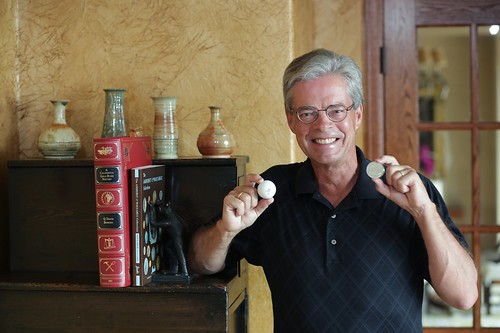
Bob Shippee holding a golf ball and a coin, two of his favorite hobbies
Pleasure and Profit: 100 Lessons for Building and Selling a Collection of Rare Coins, 2nd edition
By Robert W. Shippee; foreword by Q. David Bowers
ISBN 0794847137
Softcover, 6 x 9 inches, 328 pages, full color
Retail $19.95 U.S.
https://www.whitman.com/store/Inventory/Detail/Pleasure-and-Profit-2nd-Edition-+0794847137
To read earlier E-Sylum articles, see:
BOOK REVIEW: PLEASURE & PROFIT
(https://www.coinbooks.org/esylum_v17n50a09.html)
NEW BOOK: PLEASURE AND PROFIT, 2ND EDITION
(https://www.coinbooks.org/v22/esylum_v22n08a04.html)
NEW BOOK: NUMISMATICS AND AI
We've had a number of articles about computer vision and other new technologies that are affecting the coin hobby. Technology correspondent Joe Kerr forwarded information on a new book about numismatics and Artificial Intelligence. Thanks! -Editor
A Guide to Numismatics and Artificial Intelligence
by Isimov Asaac
 Will robots replace coin collectors?
This new book focuses on technology and numismatics and how robots can improve coin collecting. It includes chapters on the first robots in ancient times including Caligula, “the little bot" which was used to sort Julius Caesar's coin collection and then the renaissance automata which were powered by clockwork and designed by Leonardo da Vinci for the Medici family who as well as killing people collected a complete year date set of Italian pennies. It also includes a chapter on the Coinzilla series of Oriental robots from the Far East.
Will robots replace coin collectors?
This new book focuses on technology and numismatics and how robots can improve coin collecting. It includes chapters on the first robots in ancient times including Caligula, “the little bot" which was used to sort Julius Caesar's coin collection and then the renaissance automata which were powered by clockwork and designed by Leonardo da Vinci for the Medici family who as well as killing people collected a complete year date set of Italian pennies. It also includes a chapter on the Coinzilla series of Oriental robots from the Far East.
A numismatic robot is vital for the modern coin collector. Our tin friends can spend 24/7 on coins and collect work non-stop without the boring needing to rest, eat or breathe. You can programme a robot to search through junk boxes and the robot remembers all the rare dates to look for and most importantly what coins you already have. A special version of the coin robot can clean coin and polish your coins. All of these mechanical coin-collecting friends are magnetic to attract rare coins.
For more information, or to purchase, see:
A Guide to Numismatics and Artificial Intelligence
(https://www.amazon.com/A-Guide-to-Numismatics-and-Artificial-Intelligence/dp/1119467659/ref=sr_1_9)
THE BOOK BAZARRE
BOOK REVIEW: CITY OF DEVILS
James Contursi submitted this review of a non-numismatic book with a numismatic connection. Thanks. -Editor
 City of Devils : The Two Men Who Ruled the Underworld of Old Shanghai.
City of Devils : The Two Men Who Ruled the Underworld of Old Shanghai.
By Paul French. New York : Picador, (2018).
ISBN: 978-1-250-19171-7. Soft cover, 16 + 299 pages, 8 leaves of plates (some color).
Price: US$16.00
Reviewed by James L. Contursi
Anyone with more than just a cursory interest in the Shanghai tokens of the 1930s and 40s has, doubtlessly, encountered the names of “Dapper" Joe Farren and E.T. “Lucky Jack" Riley. The Shanghai of that era served as a magnet for refugees, exiles, criminals, AWOL military personnel, drifters, grifters and opportunists, and just about anybody either looking to escape a past, desperately trying to reinvent a present, or daring to imagine a future, a land of dashed hopes and a land of endless dreams, and Joe and Jack came rallying to the call.
The former, an Austrian dancer extraordinaire with huge dreams, who came to dominate the Shanghai nightlife scene as a dancer, night club impresario, manager and eventual part-owner of Farren's, the “in-est" of the Shanghai “in" spots. The latter, an ex-U.S. navy boxing champ, escaped convict, and petty criminal, who graduated to become christened the undisputed “Slots King of Shanghai." To be sure, however, neither is a hero, and this is not a story with a Casablanca ending. Together, Joe and Jack had the Shanghai underworld at their feet, and it took an invasion by the Japanese Imperial Army to bring down their criminal empires.

Two E.T. Riley tokens, the Domino Café and the 4th Marines Club, share a common reverse
While City of Devils was not intended as a numismatic work, its pages can offer a bountiful harvest of numismatic-related information, regarding the convoluted machinations employed to bring slot machines into Shanghai; the arrival of the first machines in Shanghai (early October, 1933); some backstory on the clubs and club owners that installed them; and the tokens themselves, imprinted with the club's name on one side, and, on the other side, “stamped ‘E.T.R.', which every leatherneck, squaddie, driftwood, and civilian knows stands for Edward Thomas ‘Jack' Riley…."
Although a work of non-fiction, it's written in a fast-paced, hard-boiled style, much in the vein of a Dashiell Hammett or a Mickey Spillane novel. An abundance of description paints the vivid landscape of Shanghai's dark underbelly – you can almost sense the likes of a Peter Lorre, letters of transit clenched tightly in his fist, melting into the nighttime shadows along Blood Alley, trying desperately to avoid his imminent arrest by the Kempeitai.
There are, however, two things lacking, which, if included, would have greatly augmented City of Devils. The first is a map. While naming the streets and districts through which Joe, Jack and others cruised – the Badlands, Blood Alley, Fah Wah Village, Hongkew Park, etc. – lends a sense of exoticism to the work, to the reader without a visual aid, there's no point of reference; they're reduced to not-so-meaningful names hanging in mid-air. It's clear that Joe and Jack knew the lay of the land, but their knowledge is lost to the reader.
The second is an index, the lack of which greatly diminishes the value of this book as a research tool. As mentioned above, there is much worthwhile information here, numismatic and non-numismatic, but, without an index, gleaning this data, obviously, becomes a labor-intensive exercise.
Nevertheless, French amply fleshes out some of Shanghai's many nefarious characters, about whom, previously, we had only bare-bones glimpses, names with no personae. His research is laudable and his book is heartily recommended on all fronts: as an historical reference, an enhancement of numismatic knowledge, and as a plain, old-fashioned good read. It would be no surprise if City of Devils wound up becoming the basis of a blockbuster movie.
For more information, or to order, see:
CITY OF DEVILS
The Two Men Who Ruled the Underworld of Old Shanghai
(https://us.macmillan.com/books/9781250170583)
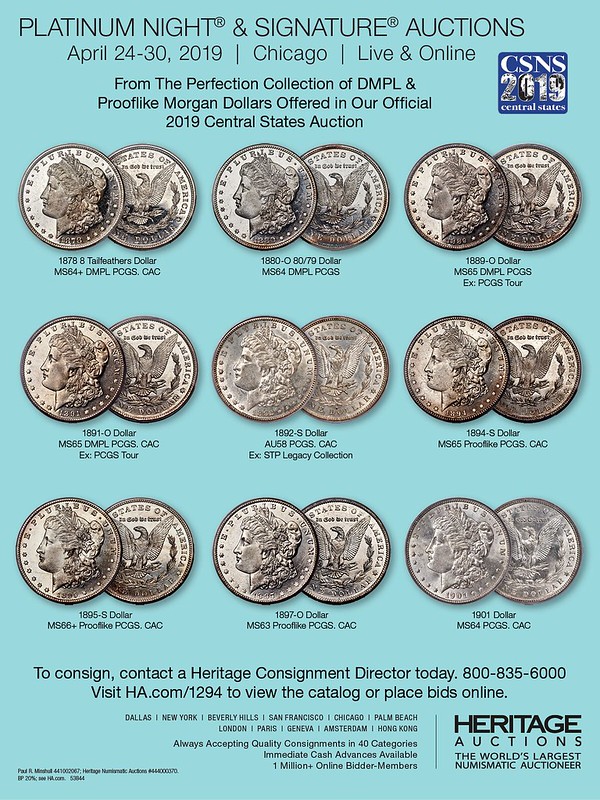
NUMISMATIQUE ASIATIQUE DECEMBER 2018 PUBLISHED
The Société de Numismatique Asiatique (The Asian Numismatic Society) has published the December 2018 issue of their journal -Editor
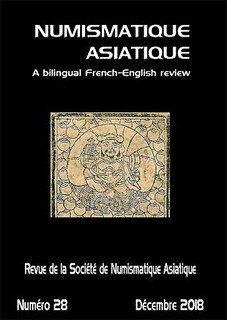 ACTS OF THE ENCOUNTERS OF LISBON
ACTS OF THE ENCOUNTERS OF LISBON
The currencies of the Portuguese Empire of Asia (16th-20th centuries)
(Second Part)
INDOCHINE
Coinage of the Indochinese peninsula according to Portuguese sources (16th and early 17th century), by Alain Escabasse
PORTUGUESE INDIA
Indo-Portuguese coinage of copper in the sixteenth and early seventeenth century:sources of supply and flow of metal by João Pedro Vieira
FRENCH INDIA
Franco-Portuguese conflict over a gold coin in 1705 by Daniel Cariou
MACAO
Some Chinese terms relating to the monetary circulation in Macaoat the end of the Qing Dynasty (1894-1911) by François Joyaux
JAPAN STUDIES
The gods on Japanese hansatsu, by Jean-Yves Lefevre
INDOCHINE
The 1935 ½ cent coin by Lindauer by François Joyaux
ARCHIVES / CHINA
On the use of cowries in China (J. Klaproth, 1834)
For more information, see:
The Société de Numismatique Asiatique
(https://sites.google.com/site/societedenumismatiqueasiatique/home)

COIN BOARD NEWS 50TH ISSUE PUBLISHED
Congratulations to Dave Lange on publishing the 50th issue of his Coin Board News newsletter! -Editor
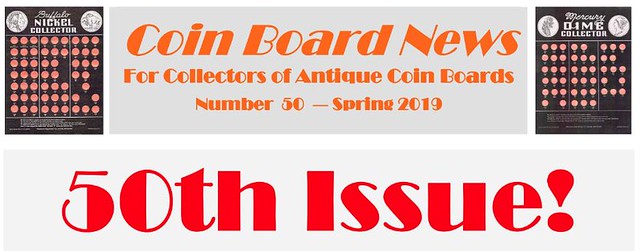
CBN Number 1 was a homely, colorless and unillustrated publication that couldn't quite fill a single page! It has since grown to several pages featuring full color photos of coin boards and associated ephemera. Many tales have been told, and many new board varieties have been chronicled within its pages. In celebration of this milestone the current issue is expanded yet again and includes a feature article about Koinpanels, wooden coin boards produced from the 1950s into the early 1980s. Several examples are illustrated, courtesy of E & T Kointainer Company President, Bernard A. Nagengast.
I closed the first issue of Coin Board News with the simple statement, "That's what's new in the world of coin board collecting," and that mission of sharing the hobby continues today.
The Koinpanel article is reproduced with permission elsewhere in this E-Sylum issue. Thanks Dave! -Editor
To read all back issues on the Newman Numismatic Portal, see:
Coin Board News
(https://nnp.wustl.edu/library/publisherdetail/511428)
For more information on Coin Board News, see:
http://www.coincollectingboards.com/
2019 ANA OUTSTANDING CLUB PUBLICATIONS
ANA member clubs should be sure to enter their newsletters and journals into the 2019 Outstanding Club Publications Competition. Here's the announcement. -Editor
Submissions Accepted for ANA's Club Publications Competition
The American Numismatic Association (ANA) is currently accepting submissions for the 2019 Outstanding Club Publications competition. The contest is open to member clubs that issued newsletters or journals four times or more during the previous calendar year, are current with their ANA dues, and do not have an elected or salaried ANA officer as editor or assistant editor. Completed submissions must be received by April 15.
Submissions must include a complete set of 2018 publications, or three different printed samples of online publications. Also required are the category of submission (local, regional, specialty, electronic), the editor's name, and the name, address, phone number and e-mail address of the submitter.
All club contestants will be entered in a drawing to receive a one-week Summer Seminar adult scholarship (age 18 or older), which covers tuition, lodging, meals and airfare. The winning club can award the scholarship as it wishes.
Judging criteria
Entries are judged on general appearance, composition, aptness of illustrations, newsiness and relative interest. Whether a newsletter is handwritten, typed or computer-generated is not a factor in judging, nor is the size of the club or the amount of funds expended.
Visit www.money.org/outstanding-club-publications for complete rules, judging criteria and submission guidelines.
Completed electronic entries can be emailed to magazine@money.org. All others should be sent to:
Outstanding Club Publications Competition
ANA Publications Department
c/o Caleb Noel
818 N. Cascade Avenue
Colorado Springs, CO 80903
For additional information, contact the Publications Department at magazine@money.org.

EARLY AMERICAN MEDALS FROM NECESSITY TO GHENT
Newman Numismatic Portal Project Coordinator Len Augsburger provided this note on a novel numismatic presentation by John Kraljevich. -Editor
John Kraljevich Opines on Indian Peace Medals in Verse
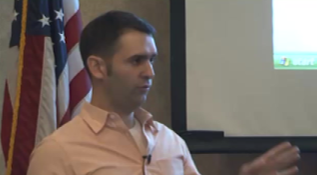 Is it possible to deliver a numismatic presentation that is at all once authoritative, compelling, entertaining, and rhyming? Indeed it is, and, to prove this is no April Fools farce, the video proof may be seen on the Newman Portal. Captured by David Lisot at the 2013 Early American Coppers convention in Newark, OH, the ten-minute talk is chock-full of couplets such as “My girlfriend objected ‘the whole thing in verse?' I know, I know, I'll have to rehearse." The Q&A portion was not delivered in verse, so there are always additional challenges for Mr. Kraljevich. Such is the spirit of the EAC that the presentation was naturally well-received. The next edition of the annual EAC convention will be held May 2-5 in Dayton, OH, and the educational forum presenters will be hard pressed to sustain the same level of creativity!
Is it possible to deliver a numismatic presentation that is at all once authoritative, compelling, entertaining, and rhyming? Indeed it is, and, to prove this is no April Fools farce, the video proof may be seen on the Newman Portal. Captured by David Lisot at the 2013 Early American Coppers convention in Newark, OH, the ten-minute talk is chock-full of couplets such as “My girlfriend objected ‘the whole thing in verse?' I know, I know, I'll have to rehearse." The Q&A portion was not delivered in verse, so there are always additional challenges for Mr. Kraljevich. Such is the spirit of the EAC that the presentation was naturally well-received. The next edition of the annual EAC convention will be held May 2-5 in Dayton, OH, and the educational forum presenters will be hard pressed to sustain the same level of creativity!
Link to Early American Medals from Necessity to Ghent on Newman Portal:
https://nnp.wustl.edu/library/book/560211
Link to David Lisot Video Library on Newman Portal:
https://nnp.wustl.edu/library/multimediadetail/522852
VIDEO: SELBY UNGAR MEMORIAL
Here's another video produced by David Lisot at a memorial to Carson City Dollar king Selby Ungar. -Editor
Selby Ungar Memorial, King of Carson City Dollars, 1937-2018
 Selby Ungar was known as the “King of Carson City Silver Dollars. He was Vice-President of the National Silver Dollar Roundtable and friend to many people in the coin industry. He was also a devoted family man. Hear his many friends share their memories of this special numismatic personality.
Donations to the "Selby Ungar Educational Fund" sponsored by by the National Silver Dollar Roundtable are being accepted by Marlene Highfill at: oklahomacoin@cox.net.
Selby Ungar was known as the “King of Carson City Silver Dollars. He was Vice-President of the National Silver Dollar Roundtable and friend to many people in the coin industry. He was also a devoted family man. Hear his many friends share their memories of this special numismatic personality.
Donations to the "Selby Ungar Educational Fund" sponsored by by the National Silver Dollar Roundtable are being accepted by Marlene Highfill at: oklahomacoin@cox.net.
A 32 minute DVD of the entire "Selby Ungar Memorial" is available for every donation received.
The entire video may viewed on the Newman Numismatic Portal at:
Selby Ungar Memorial, The King Of Carson City Silver Dollars
(https://nnp.wustl.edu/library/book/562020)
David Lisot, Interviewer, CoinTelevision.com., with Bobby Avena, Dennis Baker, Carl Bombara, Douglas Daniels, Silvano DiGenova, Vince Falcone, Ron Gillio, John & Sandie & Gulde, Brian Hendelson, Robert Higgins, Marlene Highfill, Don Kagin, Kurt Mease Jeff Rayden, Simone Rayden, Doug Sharpe, Dawn Ungar, Bernice Ungar, and Jeff Wuller.
The video is also available on YouTube at:
Selby Ungar Memorial, The King of Carson City Silver Dollars
(https://youtu.be/Lo_MaV1vobc)
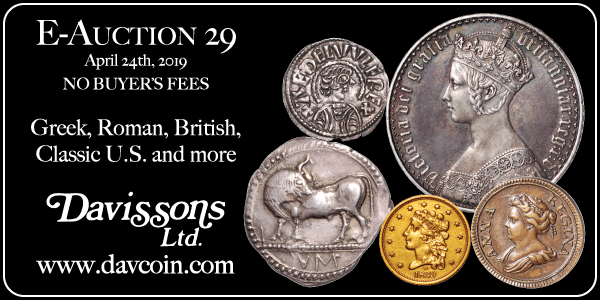
HUNGARIAN MUSEUM WASS, MOLITOR EXHIBIT
In a previous article Dave Hirt wrote about the Wass, Molitor & Co. coins given to the Hungarian National Museum by Samuel Wass. The coins have now gone on exhibit, and a nice video of the opening ceremonies has been published. -Editor
Dave Hirt writes:
Today my friend Balazs Csanady sent me a video of the opening ceremonies of the California gold coin exhibit that I previously wrote to you about. Balazs is the young man in the white jacket, first seated, later looking at the gold coins. So now you can match his name with his face!
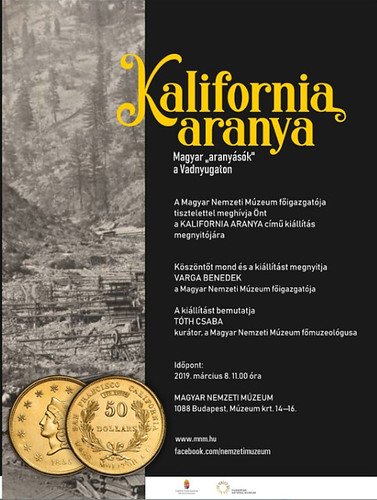

Great crowd!
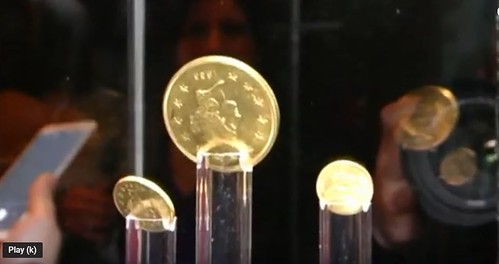
Great coins!
Many thanks to Dave and Balazs for passing along the news. It's marvelous that early pioneer U.S. gold coins given to the museum directly by their maker are still on hand and available for public viewing. The soundtrack is Pink Floyd's "Money". Check it out. -Editor
To watch the complete video, see:
Kalifornia aranya
(https://www.youtube.com/watch?v=KvblWb0sURE)
To read the earlier E-Sylum article, see:
HUNGARIAN NATIONAL MUSEUM SAMUEL WASS COINS
(https://www.coinbooks.org/v22/esylum_v22n05a16.html)
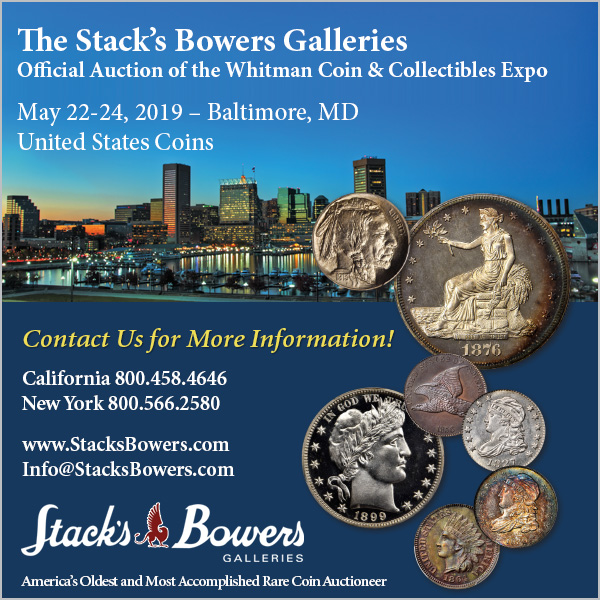
MODERN U.S. COINAGE MINTAGE ANSWERS
Dave Lange supplied this great response to last week's inquiry from Jerry Diekmann about some harder-to-find modern branch mint U.S. coin mintage figures, such as the coins struck with no mint marks. Thanks! -Editor
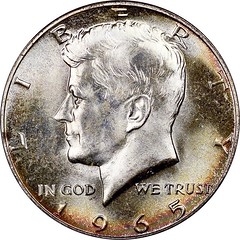
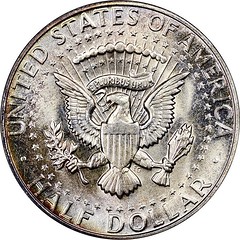
Regarding the letter requesting information about the breakdown by mints of the 1965-67 and other "anonymous" coinages, nearly all of this information is already in print. You illustrated the 1967 Annual Report of the Director of the Mint, and that does include a complete table of the coins produced at each mint bearing the dates 1964, 1965 and 1966. Those of 1964 must be included, too, as coins of this date were struck into early 1966. For 1967 and later years the publication Domestic and Foreign Coins Manufactured by Mints of the United States is quite useful. The latest print edition I've seen is dated 1980. This may or may not be available online, but print copies of this and earlier editions are easily found at a reasonable cost.
I accessed these resources when writing my 1996 book The Complete Guide to Lincoln Cents. For the anonymous San Francisco and West Point coinage dated 1975-84 I also examined the Mint Director's reports for those years, and the information was included. The only wall I hit was in trying to determine the exact breakdown of bronze versus zinc and Large Date versus Small Date cents for 1982's coinage. Even the dates when the production of bronze coins ceased and that of zinc began for each mint was unclear. I found conflicting dates from various sources and ultimately just published what I thought was the most likely to be correct.
Since the 1964-65 dated coins were produced beyond those actual years (nearly all of the 1965-dated coins were struck during 1966), their story makes for interesting reading. I've written a series of columns for The Numismatist that detail both dates' breakdowns by mints and years of production. The 1964 columns were published just recently and are available online to ANA members, but the 1965 columns have already been reproduced at the NGC website:
To read the complete articles, see:
USA Coin Album: The United States Coins Dated 1965 – Part One
(https://www.ngccoin.com/news/article/5343/)
USA Coin Album: The United States Coins Dated 1965 – Part 2
(https://www.ngccoin.com/news/article/5409/)
USA Coin Album: The United States Coins Dated 1965 – Conclusion
(https://www.ngccoin.com/news/article/5443/USA-Coin-Album/)
Tom DeLorey writes:
The mintage of the 1960 Philadelphia Small Date cent is generally accepted as being 2,075,000, that being the Philadelphia mintage of cents for January of 1960. As per custom the Mint struck about 2,000,000 pieces of each denomination in January of each year, and then struck more throughout the year as the Federal Reserve System demanded it.
As fate would have it the Philadelphia Mint then switched over to foreign coin production for several weeks, striking just under 140 million pieces in January, February and March. Over 100 million of these were in cent bronze, which may explain why cent production was skipped during this period. There may also have been a surplus of leftover 1959 cents, which were overproduced to accommodate the introduction of the Lincoln Memorial reverse design. No U.S. coins were struck at Philadelphia until later in March, by which time the date size apparently had been changed. As the time of the changeover is not known, there is no good guess as to the 1960-D SD mintage figure.
To read the earlier E-Sylum article, see:
QUERY: U.S. COINAGE MINTAGE FIGURES SOUGHT
(https://www.coinbooks.org/v22/esylum_v22n12a27.html)

THE TAD COLLECTION
John Kleeberg writes:
In February 1976 Stack's auctioned the TAD Collection, which had wonderful large cents. Many of these coins had been purchased by Doris Nelson (some sources [e.g., Breen] give her first name as Dorothy, but a Bland pedigree that I have seen gives her first name as Doris). I have long wondered what those initials, TAD, stood for. The same Bland pedigree says that the Ms. Nelson married Toby Szymanski, so the consignors were Toby and Doris Szymanski. That may be the answer - does TAD stand for "Toby And Doris"? Perhaps Harvey Stack could confirm this?
Here's the pedigree I saw - it's for an 1809/6 1/2 cent, Cohen 5:
Doris E. Nelson - Toby and Doris E. (Nelson) Szymanski (the "TAD" collection) - Stack's 3/1975:842, $500 - R. Tettenhorst Collection - Eric P. Newman Numismatic Education Society - Missouri Cabinet (Mocab 09.5.2) - Goldbergs 1/2014:96, $55,200 - D. Brent Pogue Collection - Stack's/Bowers & Sotheby's 3/2017:5062
I reached out to Harvey Stack, and here is his response. Thanks! -Editor
Does TAD stand for "Toby And Doris"? No. Now that so many years have passed since we served the lady with the initials "D.N." I can reveal her name, which was Dora Nelson. She worked for a collector in the Mid West who wanted to remain anonymous, and I cannot, after keeping it secret for all this time, reveal his true name. The initials were the ones suggested to me, T A D, which does reflect the name of the collector, but I seemed to remember that the collector had a son, whose "nickname" was given as "TAD", so the father used those initials to identify the collection.
Bland and Breen never met or talked to D.N., as we always kept her identity confidential, as asked by the collector she represented, but like all good "guessers" they may have heard someone on my staff mention a name, and projected her identity in conversations with others.
This is not the first time, nor will it be the last, that the original collector wants to remain anonymous, just like in 1949, for example, when we sold the H.R. LEE COLLECTION, for Louis Eliasberg. He wanted to sell his duplicates and felt it best not to reveal his name. In that case, the H.R. were the initials of his wife, before marriage, and the L E E was for LOUIS E. ELIASBERG.
We have used noms de plume a number of times, when the owner, or even the Estate of the collection, did not want it known how much a collection was worth, because as many told me, "Once they know you have made money, everyone wants a "Piece of the Pie" for themselves. So as loyal auctioneers, we abided by the consignor's wishes, and used an "identifying name" to identity the collection being sold, and at the same time give the coins in the collection a pedigree for the future, if one wants to attach it to his new purchase.
I just finished a story of the year 1981, which was a hectic year for all who were involved with Numismatics. During that year, we sold the famous Harold J. Bareford collection, and the 1804 Silver dollar he owned became known after the sale as the Dexter-Bareford specimen. His estate let us disclose the name.
However, later in 1981 we sold the "WESTERN COLLECTION OF U. S. GOLD COINS, " which had many great rarities in it. The bank, who was the executor of the WESTERN COLLECTOR estate, requested not to use the name of the collector in order to avoid spreading the information about to relatives and friends who knew of the collection, but had no idea of value. Here again, as with other collections sold, we used a nom de plume to conceal the owner's name.
Thanks! It's fun to explore old mysteries, even if the answers remain shrouded. -Editor
To read the TAD sale catalog on the Newman Portal, see:
United States Gold, Silver & Copper Coins, Paper Money featuring the outstanding Tad Collection of U.S. Large Cents
(https://nnp.wustl.edu/library/auctionlots?AucCoId=3&AuctionId=516513)

NOTES FROM E-SYLUM READERS: MARCH 31, 2019
Remembering Neil Rothchild
Dave Hirt writes:
I was sorry to read that Neil Rothchild had passed away. I had not spoken with him for many years, but I have good memories of him. We both attended the Frank Katen numismatic literature sales. After one evening session had ended, we talked about numismatic literature for over an hour.
He mentioned that his friend Bob Martin was looking for information on C W Betts, because Martin owned a Betts fabrication. He had been told to check Woodward, but he didn't find anything about Betts. I told Neil that the problem was that the Betts fabrications were not sold as a stand alone sale, but as an addenda to the 1864 McCoy sale. I also told Neil that Bob could find more about Betts in Counterfeit, Mis-Struck, and Unofficial U.S. Coins, by Don Taxay Pg 139-147. Later Bob Martin telephoned me and thanked me for this information.
Knowing where to find information is half the battle. I've always been a big fan of the Taxay book, and it would be great if someone tackled bringing it up to date with a new edition or totally new work. With all the reproductions made in the intervening years it would be a tall order and likely result in a multi-volume work. -Editor
To read the earlier E-Sylum article, see:
NEIL ROTHSCHILD (1956-2019)
(https://www.coinbooks.org/v22/esylum_v22n12a06.html)
Coin World - Numismatic News Rivalry
Tom DeLorey writes:
As to the demise of Numismatic News, it is my understanding that it began as an every other week publication, and only switched to a weekly format after Coin World succeeded as a weekly in 1960. I began working for Coin World in 1973, and heard many stories about our rival. The depth of the rivalry varied considerably depending upon who was telling the story.
I remember working my first coin show for CW, selling subscriptions at a Penn-Ohio show in (I think) Toledo. Cliff Mishler had a one-man NN booth next to mine, including a fancy display stand that required two people to assemble. I introduced myself to Cliff, helped him assemble his booth, and told him "Don't tell Margo!"
I believe that's correct - Numismatic News was not produced weekly at first. Great story about the booth. Nothing wrong with having frenemies. -Editor
To read the earlier E-Sylum article, see:
HARVEY STACK RECALLS KRAUSE PUBLICATIONS START
(https://www.coinbooks.org/v22/esylum_v22n12a13.html)
Query: Centenarian Numismatists
Pete Smith writes:
The E-Sylum has occasionally had items about numismatists who reach the age of 100. Can any E-Sylum reader confirm that Clyde Hubbard is still living? How about Nora Hussey? It is possible that there are currently three numismatists still living at this advanced age.
Following is a listing of old numismatists:
James E. Charleton (7/26/1911 – 9/20/2013) 102 years
William S. Dewey (12/5/1905 – 4/2/2006) 100 years
Edward Gans (8/30/1887 – 2/13/1991) 103 years
Dr. Jesse C. Green (12/13/1817 - 7/26/1920) 103 years
Robert L. Hendershott (8/7/1898 – 3/22/2005) 106 years
Genevieve T. Herdegen (8/30/1886 – 7/12/1989) 102 years
Clyde Hubbard (1916
Nora W. Hussey (3/26/1915 still living in 2017)
Robert Hepworth Lloyd (5/18/1906 – 10/10/2009) 103 years
George Francis Marlier (1/12/1868 – 9/1/1967) 99 years, 8 months
Eric P. Newman (5/25/1911 – 11/15/2017) 106 years
Nellie Tayloe Ross (11/29/1876 – 12/19/1977) 101 years
Carl Subak (1/31/1919 – still living)
Is there anyone else that I missed?
Can anyone help? This is primarily a U.S. list; who are some of the centenarian numismatists from around the world?
I knew Eric Newman fairly well and had the pleasure of meeting Bob Hendershott when he was over 100. George Marlier was a member of my hometown club, the Western Pennsylvania Numismatic Society, but passed before my time there. Numismatics is a lifelong hobby, and some of those lives can quite long. Here's to all the old timers! -Editor
On U.S. Mint Director David Ryder
Vic Mason writes:
Thank you for the good interview, in your latest newsletter, conducted by Louis Golino of CoinWeek with David Ryder, Director of the United States Mint. Mr. Ryder has clearly been thinking hard this past winter about how to make not only the Mint's typically beautiful (circulating, proof, commemorative and bullion) coins but products relevant to the revival of interest in numismatics for America's masses, especially for the kids who must be the future of coin collecting.
Mr. Ryder clearly has his heart in the right place in working with the hobby and the industry. I think he understands the issues. But, as he says, he needs both the support of the US Congress in passing enabling legislation and the understanding of the Department of the Treasury in making the important changes needed now to move the hobby forward. I think the United States government can learn a lot from the imaginative programs recently reported in designing new coins in Australia and new bills in the United Kingdom.
I heard Mr. Ryder speak this week at the Welcome Banquet for the ANA National Money Show in Pittsburgh. He's definitely bringing new ideas and energy to the position. He's brought new staff on board and I expect we'll see a number of good and interesting changes during his tenure. -Editor
To read the earlier E-Sylum article, see:
U.S. MINT DIRECTOR DAVID J. RYDER INTERVIEWED
(https://www.coinbooks.org/v22/esylum_v22n12a19.html)
U.S. Mint Shenanigans
Vic Mason writes:
John Lupia's quotations from immigrant numismatist Siegmund Kohn Harzfeld (1848-1883) -- alluding to the dubious moral caliber of some leaders of the United States Mint in the post-Civil War era – were classics. I laughed out loud to read Harzfeld's references to the 150 1879 Stellas ($4 gold pieces), which Harzfeld found were being hidden at the United States Mint and which “were available to concubines but not to collectors." Harzfeld's familiarity with Mint employees, says Lupia, “led [Harzfeld]…to become a strong critic of U.S. Mint practices" and to accuse the Superintendent of the Philadelphia Mint, James R. Snowden, of “illegally selling restrikes of the 1804 dollar."
Q. David Bowers has alerted us in recent years to the shenanigans that were often going on at the United States Mint starting in the 1830s but which intensified in the post-Civil War era. The E-Sylum article in this edition on the $50 Half Unions prompted me to check out the chapter on “Significant U.S. Patterns" (pages 1317-1324) in the First Edition of the Deluxe Edition of The Official Red Book: A Guide Book of United States Coins by Kenneth Bressett, Q. David Bowers and Jeff Garrett. The Red Book mentions the survival of “2000-plus distinct varieties“ of patterns, some “made in secret, outside the normal day-to-day work of the Mint…and often against stated policy and law….Not until mid-1885 did an incoming new director of the Mint enforce stringent regulations prohibiting" the sale and distribution of such patterns.
Ron Chernow's excellent biography of Ulysses S. Grant – as outstanding as his prior books on Alexander Hamilton and George Washington – makes clear that Grant, president during much of this time, was a scrupulously honest man, with many fine Cabinet Secretaries. But, in office between 1869 and 1877, Grant could also be excessively, even blindly, loyal to those whom he trusted, some of whom were not deserving of that faith and trust – as he would often discover later, to his chagrin. As Chernow writes (page 733), “Grant had made a genuine effort at civil service reform and deserves credit as the first president to do so, but he hadn't produced lasting change. Only with the 1883 Pendleton Act would competitive exams be required to fill a portion of federal jobs."
Great observations. Thanks. -Editor
To read the earlier E-Sylum articles, see:
SIEGMUND KOHN HARZFELD (1848-1883)
(https://www.coinbooks.org/v22/esylum_v22n12a15.html)
KAGIN'S MARCH 2019 ANA AUCTION PREVIEW : 1877 $50 Half Union Pattern
(https://www.coinbooks.org/v22/esylum_v22n12a20.html)
Anne Bingham and the Draped Bust Dollar Design
Dave Lange writes:
Every now and then I find an opportunity to contribute to a non-numismatic publication. A recent article in American History Magazine prompted me to send the editor a letter, and this was printed in the June issue.
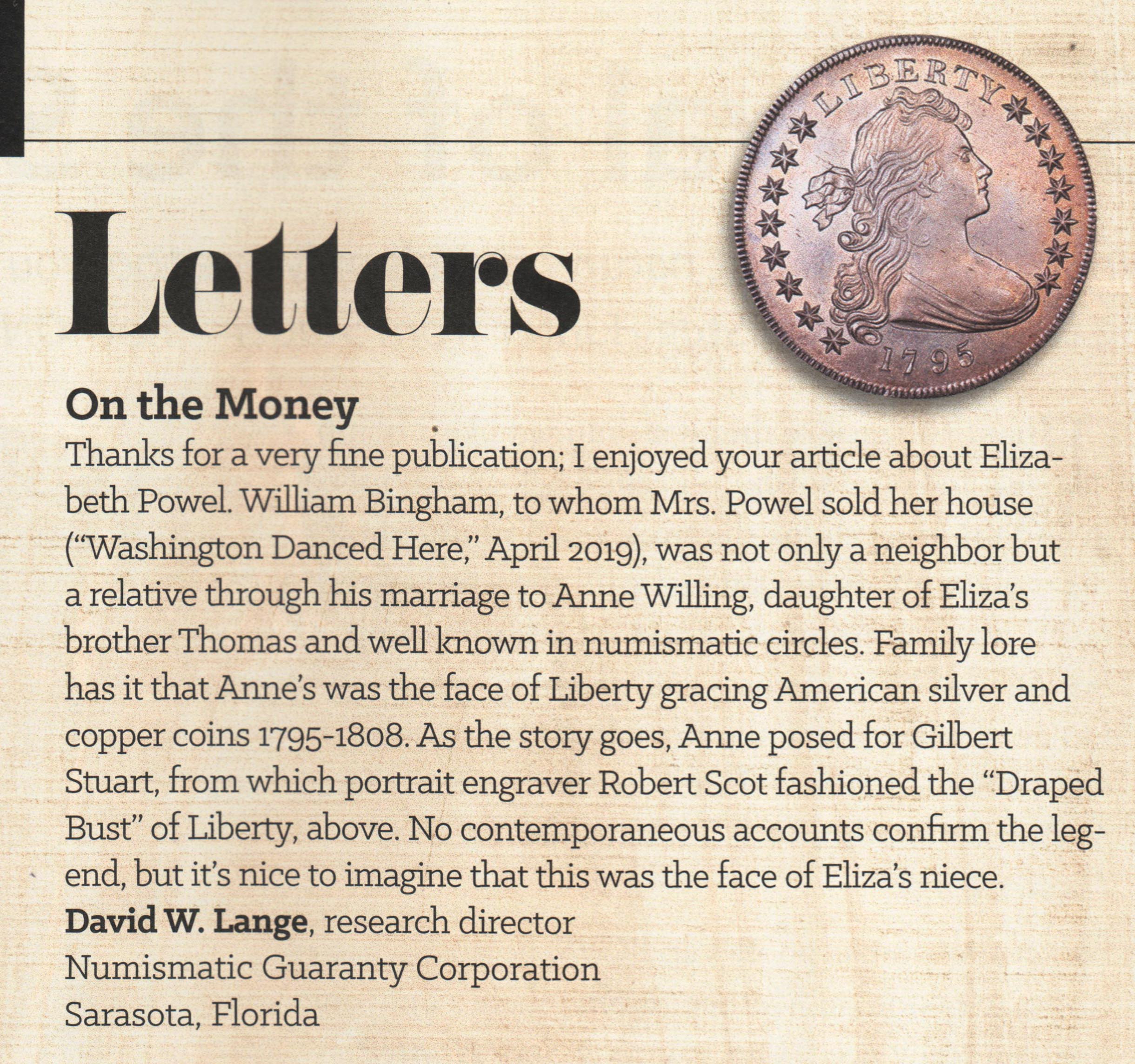

MORE ON THE FIP AND FIPPENNY BIT
John Kleeberg submitted these notes on the Fip and fippenny bit. Thanks! -Editor
Fip and fippenny bit - As Albert Frey explains in his dictionary, the "fip" or a "fippenny bit" is Spanish-American 1/2 real (a "medio" or "picayune"), worth 6 1/4 cents in Federal currency. The name arose because a 1/2 real was worth fivepence halfpenny plus a half farthing in the Middle Atlantic money of account ($1 = 90 pence) that was used in Pennsylvania, western New Jersey, Maryland and Delaware. (90 divided by 16 = 5.625.) A related term is the "levy," "elevenpence" for the Spanish-American real, worth 12 1/2 cents in Federal currency, because that coin was worth eleven pence one farthing in the Middle Atlantic money of account. (90 divided by 8 = 11.25.)
These terms are mentioned in Phil Mossman's Money of the American Colonies and Confederation, pages 57 and 157.
In New York, by contrast, where the dollar was worth 96 pence in the money of account, the "real," which would be called a "levy" in Philadelphia was known as a "shilling," and the "1/2 real," Philadelphia's "fip," was known as a "sixpence."
And in New England, where the dollar was worth 72 pence in the money of account, these coins were known as "ninepence" and "fourpence halfpenny."
Spanish-American coins were legal tender in the United States until 1857; and the evidence of counterstamps tells us that these coins continued to circulate in the United States as late as the 1870s. So there was a need for these names - hence the persistence of the terms levy, fip, shilling, sixpence, ninepence, and fourpence halfpenny.
To read the earlier E-Sylum article, see:
NOTES FROM E-SYLUM READERS: MARCH 24, 2019 : Fippence and Fippenny in England and Canada
(https://www.coinbooks.org/v22/esylum_v22n12a12.html)
FIRST ELECTRONIC MONEY IDENTIFIER FOR THE BLIND
Tom Babinszki is looking for the first electronic money identifier for the blind. Can anyone help? -Editor
I am looking for the first electronic money identifier for the blind. Here is the information I have: It was developed by NASA in the early 1970's, and produced by Marchak Engineering, which doesn't appear to be in business today.
Here is a description of the device:
"The first reliable paper money identifier to aid blind business persons has been developed from NASA technology. The device identifies paper money by its sound "signature." As a bill is passed under a light source, a photo-transistor measures changes in the bill's light patterns. These changes are converted into "beeping" sounds by an oscillator. Since each denomination of paper money has a different pattern a different series of tones is given off. These differences are easily identified after only about three hours of practice. NASA technology which led to development of the device stems from a technique for the semi-automatic inspection of microfilm records first reported in 1969. The Marchak Engineering and Manufacturing Co., Austin, Tex., produces the device commercially."
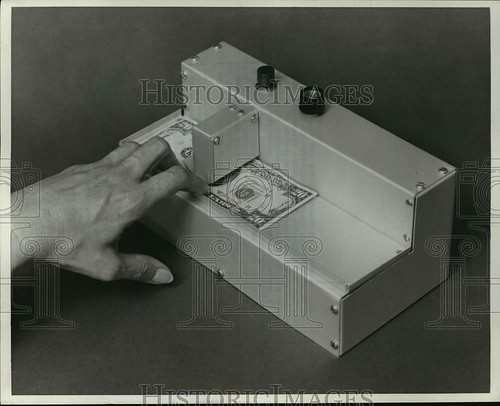
Also, recently somebody was selling a photo of the device on eBay if it helps to identify the device:
https://www.ebay.com/itm/1973-Press-Photo-Device-for-Reading-Money-for-the-Blind-mja45965-/392150972987
I am looking for further information about the device, practically all I have is the above quote. I would appreciate any information or any contacts. Ideally, I would love to get one of these devices preferably in working condition, but I'm interested in any solutions.
Thank you for your help.
Interesting. There must be one out there somewhere waiting to be discovered. -Editor

VOCABULARY TERMS: SERIES
Dick Johnson submitted these entries from his Encyclopedia of Coin and Medal Terminology. Thanks. -Editor
Series. An issue of a number of numismatic or medallic items with a common theme or design and a continuity in their issue. When a number of related items are issued at one time, this is considered a set. It is only when similar items are issued over a period time that constitutes a series. The concept of series developed with the early precepts of medal marketing. A collector of medals, an early publisher (James Mudie) reasoned, would want more than one medal to form a collection, or suite of medals. Why not supply this finite number on a subscription basis to form a ready made collection? Thus medals were issued in series periodically with a single continuity of theme.
For the next two centuries the most popular themes for series have been the heads of state, church, numismatic and professional organizations – or art medals for collectors. English kings have been recorded by medal series, the French created a series for their famous Frenchmen, and, while not intended as a series, Papal medals have been issued for a thousand years.
Art series, in contrast, are issued for the sheer pleasure of owning an attractive medallic work of art. The first began in 1889 when the French medalist Roger Marx created the Société des Amis de la Médalile Française. A similar organization was founded in Brussels in 1901 for Dutch and Belgium medalists, Société Hollandaise-Belge des Amis de la Médaille d'Art.
Coin series. A series of coins is usually a run of similar items of the same denomination and type. These are generally the creation of one or two artists with the design repeated. These are identified by year of issue and the date they bear, and often a mintmark indicating the mint of issue. Thus a series of coins differ only slightly from each other despite the fact they are issued over a period of years.
Medal series. Medals in series, however, are generally uniform in size, shape and composition – but not necessarily by the same artist. Series medals are usually sold by subscription and issued over a period of time, where maybe one or two medals are released at a time. Also similar medals by the same publisher issued over time may be considered a series by collectors and numismatists where, perhaps, they were not so intended originally; the series of presidential medals issued by the United States Mint is such a series.
History of medal series. To James Mudie (flourished 1815-20), a London entrepreneur, must be given credit as the first medal publisher to issue medals – by series – on a broad basis. For his Mudie's National Medal Series of forty medals, he hired Edward Thomason (1769-1849) to strike the medals (beginning in 1820) in his Birmingham plant from dies engraved for the most part by French engravers.
Thomason went on (without Mudie) to create a 48-medal series on the Elgin Marbles, a 16-medal series, the Medallic Illustrations of Science and Philosophy, the 36-medal series of the Kings and Queens of England. His most notable medallic undertaking, however, was his famed 60-medal series: the Thomason Medallic Illustrations of the Bible.
The Paris Mint issued their first series of medals in their famous Frenchmen of the 18th century. Here, like the later U.S. Mint, these may not have originally been intended to be a series, but similarity of issue bring to mind this classification by numismatists and that is how they are collected.
U.S. Mint series. A most interesting early series was the American Art-Union Medals as prize medals to promote a lottery similar to an undertaking in England. Each medal bore a portrait of a contemporary artist: Washington Allison (1847), Gilbert Stuart (1848) and John Trumbull (1849). The medals were struck at the Philadelphia Mint and distributed to member-subscribers.
Following the Civil War the United States Mint gathered together several 3-inch medals bearing portraits of the American presidents already issued. It added the few missing presidents and continued this until the present day for, perhaps, the longest running series (but not the largest number of medals in a series) in America.
The U.S. Mint began a series with three furtive issues in 45mm size: the Union Pacific Railroad Medal, 1869 (CM-39), Emancipation Proclamation Medal, 1871 (CM-16) and the Grant Peace Medal, 1872 (PR-14). The first and third bore Grant's portrait, the second with Lincoln's. Each medal bore the inscription "Medal Series of The U.S. Mint," but nothing more was issued.
While Congress bestowed medals to heroes of land and naval battles from the War of 1812 onward, these were grouped together into somewhat of an ersatz series when the first List medals were offered for sale to the public after the Civil War. Today the U.S. Mint issues medals in their series of Secretaries of the Treasury, Mint Directors, and Mint Buildings.
Private U.S. series. The Numismatic and Antiquarian Society of Philadelphia began honoring their president in 1884 with a medal of Charles Edward Anthon. They sought out Lea Ahlborn at the Swedish Royal Mint to prepare the dies and strike the medals. She also engraved the second medal in the series in 1890, two more medals were struck before the series closed, the final medal was of Joseph J. Mickley.
The concept of a presidential medal for the head of another numismatic organization appealed to the members of the New York Numismatic Club. They commenced their series in 1911 with the portrait of Frank C. Higgins. Fortunately they had not one, but two medalists within their own membership. So they had Jonathan A. Swanson prepare the portrait obverse, and Victor D. Brenner the symbolic reverse. By the end of the century they had all 40 presidents honored – the longest running such series still in existence. Brenner's reverse has appeared on all.
Other numismatic organizations adopted similar medal programs to honor their leaders. The Rochester Numismatic Association began a series in 1913; their president served for only one year so they had 87 medals in their presidential medal series before the end of the century, for the greatest number of such medals. The Token and Medal Society, founded in 1960, has such a presidential medal series, as does the California State Numismatic Association, and others. In the professional field, the American Institute of Architects have a president medal series.
Private medal series. Modern private collector medal series in the United States began with the Circle of Friends of the Medallion in 1907, where it lasted for 12 issues within six years. It was modeled after medallic societies in France and Belgium mentioned above. In 1930 the Society of Medalists was born on the same basis of two medals a year by prominent American sculptors. It continued an unbroken 60- year record of two highly artistic medals for 129 issues, until 1995. Every noteworthy American medalist of the twentieth century (with the obvious exceptions of Saint- Gaudens and Victor Brenner who both died before the inception of The Society) are represented in this series.
A small coterie of companies arose in the 1960s for the purpose of issuing medals in series. The most noted, perhaps, was Presidential Art Medals; this firm published series on U.S. presidents, states, signers of the Declaration of Independence, medicine, aviation, great religions of the world, and major events of World War II.
But medals in series experienced a boom in the 1960s with the rise of private mints. Franklin Mint, the first and most productive, issued over 60 different series from 1960 to 1980 when the demand dissipated. The market, it was learned, just could not absorb any more such series at the time.
Aborted Series. A small number of series are aborted before completion of their announced intentions. Often this is the result of the death of an artist who intended to do the entire series. Examples of this include Ralph J. Menconi (1915-1972) who died before the full compliment of 25 medals in his Great Religions of the World Series were struck. Sixteen medals were issued before his November 1972 death, he had prepared the models in advance for two additional medals and these were issued in due course. Seven of the 25, however, were never issued.
In other cases the result of the cessation was lack of interest or poor sales. The series of Philip Kraczkowski (1916-1996) were particularly noted for this. Only three of his Executive Branch Series were issued, one of his Musical Hall of Fame Series, and three Living Free Series.
Looking for the meaning of a numismatic word, or the description of a term? Try the Newman Numismatic Portal's Numismatic Dictionary at: https://nnp.wustl.edu/library/dictionary
Or if you would like a printed copy of the complete Encyclopedia, it is available. There are 1,854 terms, on 678 pages, in The Encyclopedia of Coin and Medal Technology. Even running two a week would require more than 19 years to publish them all. If you would like an advance draft of this vital reference work it may be obtained from the author for your check of $50 sent postpaid. Dick Johnson, 139 Thompson Drive, Torrington, CT 06790.

GEORGE WILLIAM RODE (1858-1904)
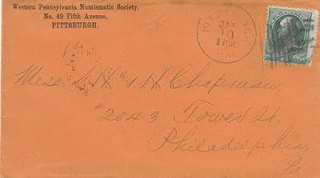 George William Rode (1858-1904), was born the eldest child and son of immigrant parents; his father was from Hanover, Germany, George Christian Rode (1826-1890), a medical cupper and a barber, and his mother Sarah Ann James (1835-1881), from Donegal, Ireland.
George William Rode (1858-1904), was born the eldest child and son of immigrant parents; his father was from Hanover, Germany, George Christian Rode (1826-1890), a medical cupper and a barber, and his mother Sarah Ann James (1835-1881), from Donegal, Ireland.
In 1863, he worked as a clerk for Mutual Life Insurance Company of New York, Pittsburg Office, Pittsburg, Pennsylvania. Over time he was promoted to cashier.
Founding member and first Secretary of the Western Pennsylvania Numismatic Society, George Rode occupied the position for most of the Society's first eleven years. If any one individual deserves special recognition for service to the Society during its formative years, it is George Rode. Then as now, the Secretary is the workhorse of the Society, writing minutes of every meeting and handling correspondence with other collectors and Societies.
His collection was sold posthumously by Geoffrey Charleton Adams on March 31, 1905.
In 1877, he lived in his family home where his father ran a barber shop at 1933 Carson Street, Pittsburgh, Pennsylvania.
Although a cashier, Rode is listed as a clerk [bookkeeper] in the 1878 Pittsburgh City Directory, working at 49 Fifth Avenue.
He was a corresponding member of the ANS since November 16, 1880.
On March 15, 1881, he married Pittsburgh native Anna Mary Hartman (1861-1937). They had two children : Lillian Rode (1882-1959), and Harry H. Rode (1882-).
Rode became ANA Charter Member No. 12, who was nominated by founder George Heath to serve on the organization's "Board of Temporary Organization." Rode also briefly served as the ANA's Superintendent of Exchange from 1891 to 1892. He served as Secretary at the 1892 ANA Pittsburgh Convention.
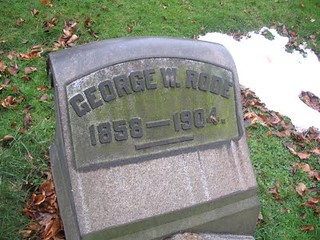 He pointed out that coin and stamp dealers Brennan and Mason issued store cards in response to an article published in The Numismatist in 1902.
He pointed out that coin and stamp dealers Brennan and Mason issued store cards in response to an article published in The Numismatist in 1902.
He died of typhoid at his home 423 Whitney Street, Wilkinsburg, Pittsburg, Pennsylvania, on July 30, 1904.
To read the complete article, see:
RODE, GEORGE WILLIAM
(https://sites.google.com/a/numismaticmall.com/www/numismaticmall-com/rode-george-william)
The entire inventory of the Lupia Numismatic Library is for sale. Individual items will be available before the remaining archives are broken up into parcels sold at philatelic auctions in the U. S. and Hong Kong. Check NumismaticMall.com frequently as dozens of new items with estimates will be posted daily until everything is sold.
All inquiries will be given prompt and courteous attention. Write to: john@numismaticmall.com .

CHICAGO INDUCTS VIRGIL BRAND INTO HALL OF FAME
The Chicago Coin Club has announced the fourth inductee into its Hall of Fame. -Editor
Inducts Virgil Brand Into its Hall of Fame
The Chicago Coin Club announces that the fourth person to be inducted into its Hall of Fame is noted collector Virgil Michael Brand, 1862-1926, who formed the greatest private collection of coins in the world. His Hall of Fame citation has been published on the club's Hall of Fame web page, www.chicagocoinclub.org/projects/hof .
Twelve Hall of Fame inductees have been selected. Each of the remaining eight will be announced at the rate of one per month, May through December, during the Chicago Coin Club's centennial year, 2019.
The Chicago Coin Club was organized in 1912 as American Numismatic Association Branch No. 1, and reorganized under its present name in 1919. All are invited to join. To become a member you must attend a meeting and submit an application along with a membership fee of $20 ($10 for Junior membership). A first reading of your application will be held at this meeting, and a second reading at the next monthly meeting, following publication of your name in the club newsletter. (You are not required to be present for the second reading.) Upon membership approval, you will become a member.
The Chicago Coin Club holds monthly meetings in downtown Chicago, plus at major numismatic conventions such as Central States, with a speaker featured at every meeting except the annual auction, held at the November meeting.
Here is the text of the Virgil Brand entry. -Editor
 Virgil Michael Brand was a charter member of the predecessor Chicago Numismatic Society and served as its President 1908-1909. He joined the Chicago Coin Club during its first year of existence, becoming member number 55 on Dec. 3, 1919. Mr. Brand retained his membership the rest of his life, though he soon stopped coming to meetings due to failing health. While he never held office in the club, he exhibited rare gold coins at its ninth meeting as a visitor. And the great collector had an impish side: at the January 7, 1920 meeting he amused members by reciting a humorous poem (probably his own composition) entitled “The Quarrel of the Coins," in which the characters were an Indian Head cent of 1909, an 1883 nickel without cents, an 1802 half dime, an 1804 dollar, and “the villain," who was a coin collector. This was greatly appreciated, and attendees clamored for more!
Virgil Michael Brand was a charter member of the predecessor Chicago Numismatic Society and served as its President 1908-1909. He joined the Chicago Coin Club during its first year of existence, becoming member number 55 on Dec. 3, 1919. Mr. Brand retained his membership the rest of his life, though he soon stopped coming to meetings due to failing health. While he never held office in the club, he exhibited rare gold coins at its ninth meeting as a visitor. And the great collector had an impish side: at the January 7, 1920 meeting he amused members by reciting a humorous poem (probably his own composition) entitled “The Quarrel of the Coins," in which the characters were an Indian Head cent of 1909, an 1883 nickel without cents, an 1802 half dime, an 1804 dollar, and “the villain," who was a coin collector. This was greatly appreciated, and attendees clamored for more!
Mr. Brand (Jan. 16, 1862 – June 20, 1926)'s father Michael came from Germany in 1848 and later moved to Blue Island, where he found work as a brewer and where Virgil was born. Michael was soon made a partner in the firm, and Busch & Brand's beer became so popular that they had to make daily trips to supply Chicago's saloons. After a dispute, the business was divided, with Michael Brand & Company being established in Chicago. This business eventually merged with other brewers, and was later sold, allowing Michael Brand to retire a wealthy man.
Virgil Brand graduated from Bryant and Stratton College in Chicago and went to work as a bookkeeper for his father's firm. He became secretary and treasurer of the brewery with one tenth ownership, and received a great deal of money when his father cashed out. In 1899 he established his own brewery, the Brand Brewing Company, with an eventual capital of $1,000,000, which operated until shut down by Prohibition in 1920. A lifelong bachelor, he devoted his free time to coin and currency collecting, beginning in 1889.
Mr. Brand formed the greatest private collection of coins in the world, buying individually, in groups, and entire collections en bloc. He recorded every acquisition in a series of ledgers. At his death the collection included over 350,000 pieces (worth $2,000,000 according to a European dealer with knowledge of the collection), plus a substantial numismatic library. He left no will; his collection was fought over by his heirs and broken up. His paper money collection was largely turned in at face value, but the balance was purchased by B. Max Mehl and offered for sale in 1932; his coins and library formed part of over a dozen auctions, with many being sold directly.
Mr. Brand showed that he was a scholar-collector, and not a mere hoarder, in a paper read at the April 1905 meeting of the Chicago Numismatic Society, “The Objects of Coin Collecting," published in
To read the complete article, see:
In his Stack's Bowers blog post this week Dave Bowers wrote:
"For this week's commentary I share an article by Virgil Brand that appeared years ago in The Numismatist, May 1905. The concepts have not changed in the intervening years!"
Here's the complete article.
-Editor
Hall of Fame
– Chicago Coin Club –
Member 4
Virgil Michael Brand
(http://www.chicagocoinclub.org/projects/hof/m04.html)
VIRGIL BRAND ON THE OBJECTS OF COLLECTING
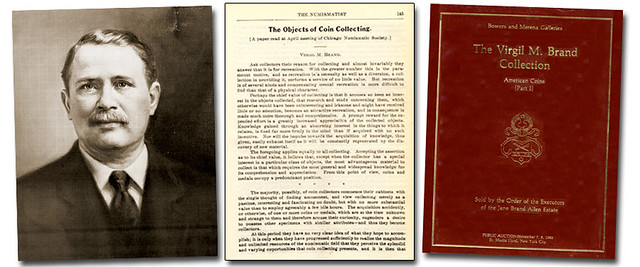
Ask collectors their reason for collecting and almost invariably they answer that it is for recreation. With the greater number this is the paramount motive, and as recreation is a necessity as well as a diversion, a collection in providing it, provides a service of no little value. But recreation is of several kinds, and compensating mental recreation is more difficult to find than that of a physical character.
Perhaps the chief value of collecting is that it arouses so keen an interest in the objects collected, that research and study concerning them, which otherwise would have been uninteresting and irksome and might have received little or no attention, becomes an attractive recreation, and in consequence made much more thorough and comprehensive. A prompt reward for the expended effort is a greatly increased appreciation of the collected objects. Knowledge gained through an absorbing interest in the things to which it relates, is fixed far more firmly in the mind than if acquired with no such incentive. Nor will the impulse toward the acquisition of knowledge, thus given, easily exhaust itself as it will be constantly regenerated by the discovery of new material.
The majority, possibly, of coin collectors commence their cabinets with the single thought of finding amusement, and view collecting merely as a pastime, interesting and fascinating, but with no more substantial value than to employ agreeably a few idle hours. The acquisition accidentally or otherwise, of one or more coins or medals, which are at the time unknown and strange to them and therefore arouse their curiosity, engenders a desire to possess other specimens with similar attributes—and thus they become collectors.
At this period they have no very clear idea of what they hope to accomplish; it is only when they have progressed sufficiently to realize the magnitude and unlimited resources of the numismatic field that they perceive the splendid and varying opportunities that coin collecting presents, and it is then that they define more clearly to themselves the objects and purposes for which they henceforth collect.
Naturally these will differ greatly and will vary according to the inclination of the individual, depending upon which features of numismatics appeal to him most forcibly. Some will find the speculative possibilities the greatest attraction and will collect only for the purpose of financial gain; these, however, should be considered dealers, rather than collectors.
Many restrict their efforts to coins of a selected period or locality, or of a certain metal or denomination, or gather only specimens relating to one or more separate related subjects. Collectors adopt a great variety of limitations, some of them unique. For example, one collector confined himself to coins from dies with errors, another to those bearing representations of animals, and still another limited the animals to elephants. But all, no matter how much they have restricted their field, realize early in their collecting experience that in order to proceed intelligently and arrive at a proper and thorough comprehension of their coins, research and study more or less exhaustive is imperative. To the collector's zeal is now added a craving for knowledge, and his cabinet becomes a powerful and valuable influence in favor of education.
The branches of learning to which the science of numismatics is related are numerous, and many collectors specialize, selecting one or more of them, according to their inclination or interest. It is a part of archaeology and is a valuable aid in the study of mythology, heraldry, iconography, and other subjects. But its relation is closest to history; in fact coins have been freely employed in revising the latter, and much valuable historical data rests entirely upon their testimony.
In the domain of art, coins and medals occupy an important place. They furnish instantaneous ocular proof of the attained stage in its development at all times, and are unimpeachable contemporaneous witnesses to its progress. Nothing will illustrate more strikingly the advance of art, from the crude attempts in the earliest times until it reached its greatest perfection, centuries later—its gradual decline and almost total eclipse during the darkness and turmoil of the Middle Ages and its rejuvenation thereafter, than a series of coins covering the period involved. The features of numerous historical personages, as well as the costumes worn in past ages, are known to us only from coins and medals, on which they are faithfully reproduced by contemporary artists.
The economist may be chiefly interested in coins as money and will find his cabinet indispensable in the study of the monetary systems of nations, the relative value of the precious metals at various periods, the fineness and weights of the world's coins, and the purchasing power at different times and in different localities.
The true numismatist, while he may specialize in a kind or class of coins, does not do so in his researches concerning those he collects, but strives to acquire a full knowledge of everything pertaining to them. He notes the size, weight, composition, shape and date of issue of each specimen and learns its name and place in the monetary system of the times. He investigates the causes of its rarity, if it is rare—due perhaps to it being one of the small emission or of a recalled issue—and if the latter he tries to learn the cause for the recall.
To the uninitiated, all of this may seem a formidable task, but in reality it is far from being so. Careful study of the history of the nation or other authority issuing the coins will yield the greater part of the desired information; some portions of it, of course, must be derived from special sources, and this last applies peculiarly to researches concerning coins issued without the sanction of any constituted authority (private coins).
The above points are worth considering.
Amen. Well said. -Editor
To read the complete article, see:
The Obects of Coin Collecting
(https://www.stacksbowers.com/News/Pages/Blogs.aspx?ArticleID=3329)
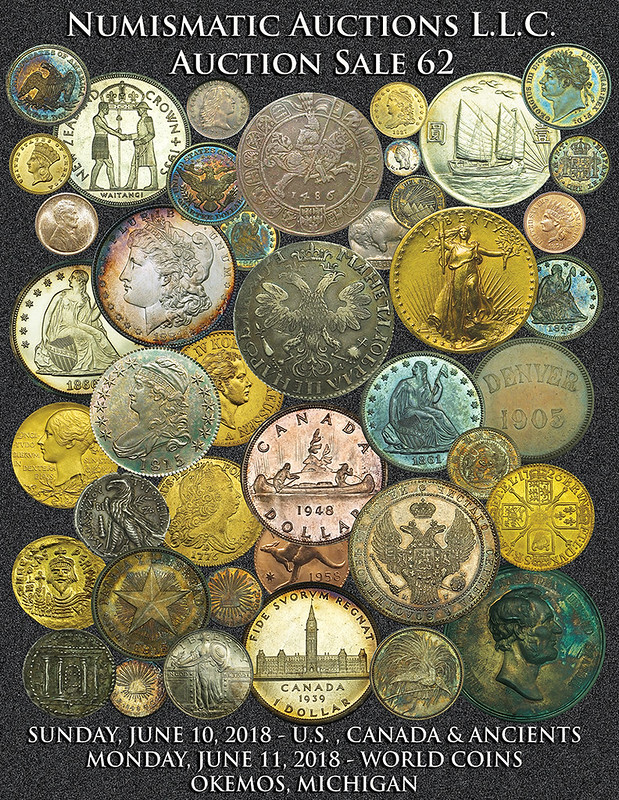
BOWERS: JOURNAL OF EARLY AMERICAN NUMISMATICS
Martin Kaplan forwarded this Coin Update article (also by Dave Bowers) reviewing the Journal of Early American Numismatics (JEAN). Thanks. -Editor
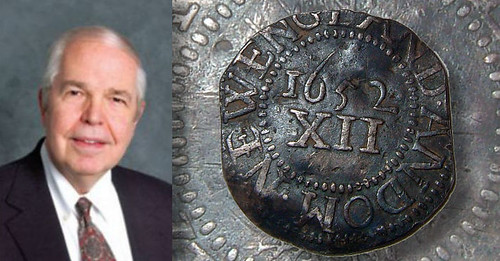
There is a peculiar aspect to the spending habits of most collectors. In a wink, and with little thought, many will spend $1,400 or so for a one-ounce gold coin. When it arrives, it is put in a safe deposit box. It yields little in the way of pleasure and enjoyment. Ask the same collector if he or she will spend $500 per year on subscriptions to numismatic organizations and for books and the answer is usually, “I don't spend nearly that much." The same person is obsessed with grades and prices, and that's about it.
Longevity of interest in numismatics is best achieved by learning about the art, history, science, and romance of coins, tokens, medals, and paper money. The easiest, best, and least expensive way to do this is to build a modest working library of interesting and informative numismatic books.
A new entry in the field is the Journal of Early American Numismatics, two book-sized publications issued twice a year by the American Numismatic Society. Each is between 175 and 225 pages and is extensively illustrated. The editor is Christopher McDowell, whose specialty is research—unearthing facts and information not easily available. To this effort is added information from standard sources. The result is that a study of a particular item is apt to be definitive. There is a danger in JEAN however. You might want to rush out and buy a featured item, and that could cost you more than a one-ounce gold coin!
A year's subscription costs $80, or if you are a member of the American Numismatic Society, $65.
Chris McDowell has just informed me of this:
"Subjects for June issue include: A new and interesting variety of Massachusetts Pine Tree shilling; the Potosi Mint in South America and its impact on American coinage; new information on the Massachusetts Pine Tree copper coin of 1776; a new variety of George III counterfeit halfpenny that circulated in America; an article on the life of John J. Ford and his impact on numismatics, a study of the 1787-dated Fugio restrikes and their relationship to the original Fugio coinage; an overview of Lion dollars made in Holland that circulated as legal tender in America; and much more. All that and more in just one issue! Topics for the December issue that can be confirmed include – a full accounting of Miss Banks American colonial coin holdings with images and her papers relating to American coins; a complete study of Pitt tokens, and, of course, much more."
Though Sir Arthur Conan Doyle no longer lives, we may never learn more about Sherlock Holmes and the giant rat of Sumatra or the singular adventures of the Grice Patersons in the Island of Uffa, you can learn about Miss Banks' singular contribution to a first-class American numismatic mystery that is still ongoing. As to the Ford article mentioned by Chris, as you read these words, I am in the process of finessing it for the June issue of JEAN. Full disclosure: I am a fellow of the ANS but have no vested interest in JEAN. I pay the same price for my subscription that others do.
Get ready! Get set! Go for it!
To read the complete article, see:
Bowers on collecting: I challenge you to spend $80 and open a new world!
(http://news.coinupdate.com/bowers-on-collecting-i-challenge-you-to-spend-80-and-open-a-new-world/)

HISTORY OF THE KOINPANEL
In the Spring 2019 issue of his Coin Board News, Dave Lange published a nice history of the rare Koinpanel product from the E & T Kointainer Company. I'm republishing it here with permission. Thanks. -Editor
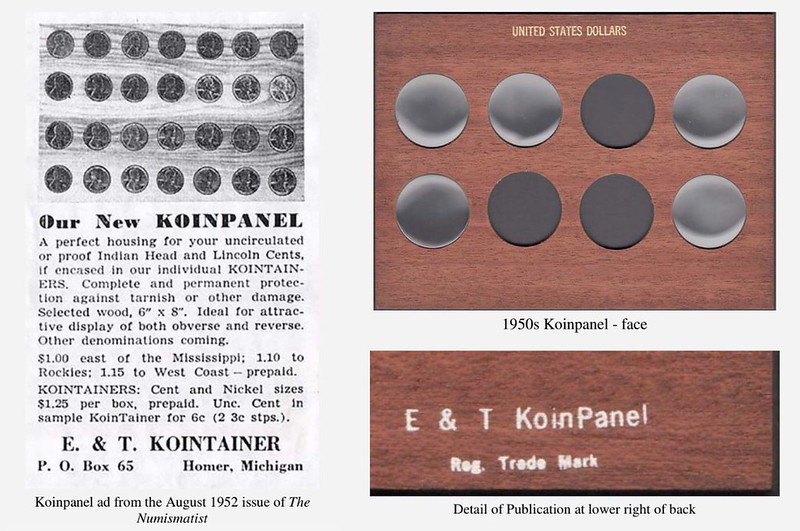
THE KURIOUS KOINPANEL--- Bernard A. Nagengast contacted me recently to inquire whether I'd like to publish his history of a coin board he manufactured and sold during the 1980s under the name Koinpanel. This immediately stirred a memory from that time when I actually purchased a Koinpanel from his E & T Kointainer Company to house my set of Kennedy Half Dollars. I'd transferred all of my modern coins into Kointains, which are inert, clear plastic lenses that friction fit over the obverse and reverse of a coin. These could then be inserted into the openings of the Koinpanel, resulting in a coin board that permitted viewing both sides of the coins. Needless to say, I welcomed his reminiscences about the company and its products. Too long to reprint in its entirety, I'm including here my summary of the main points.
In the late 1940s a collector named Francis S. Epps noticed that some of his coins were deteriorating due to the primitive state of coin storage products at the time, and he set about finding a solution. Consulting with a research chemist named Trainer (spelling uncertain), he selected ethyl cellulose as the ideal plastic for chemical inertness and malleability. The end product was the "Kointain," a two-piece capsule that was convex so as to not contact the coin except on its edge. E & T Kointainer Company was established in 1950, and ultimately holders of many sizes were offered. Epps bought out his partner and continued the business until his death in 1973. Bern Nagengast purchased the rights five years later and has operated the company ever since. It still manufactures and sells the Kointain capsules.
Francis S. Epps sought a display product for his Kointains and came up with a hardwood veneer plywood board with openings cut to fit various sizes of coins. The Koinpanel debuted in 1952 in a standard size of 8" wide x 6" tall x 3/16" thick. African Mahogany was the default wood, but Rosewood was available at a higher price. These were drilled and labeled in gold-colored hot type for various coin denominations, and a smaller 8" x 3" Koinpanel was added for proof or mint sets.
When Bern Nagengast purchased the company from Epps' successors he acquired a large back inventory of these panels, which had enjoyed only limited sales over the years. Collectors suggested to him that a larger format Koinpanel that could hold all or part of a coin series would be much more desirable, and he set about to produce such an item. He discovered that the woods used by Epps were either unavailable or unaffordable, but he found a suitable replacement in Honduran Mahogany. The new Koinpanel measured 8" wide by 12" tall.
The decision was made to start with the most popular coin series—cents back to 1857, nickels back to 1883, silver coins back to 1892, etc. To reduce the number of different die cuts, he settled on eight panel arrangements. He had the drilling equipment from Epps to cut the openings, but hot type had become obsolete, so he sought a new lettering/numbering technique. The simple solution was the dry transfer type sold by stationery stores. He custom ordered 2000 sheets that included every combination of titles, dates, mints, etc. that he anticipated would be needed.
The new Koinpanel line debuted in 1982, but it was destined to last only a year or so. Production was labor intensive, sales were disappointing, and collectors sometimes complained that the Kointains were difficult to insert into the openings. Indeed, I found this to be true of my Kennedy Half Dollar panel, and I declined to order any more Koinpanels. Bern Nagengast estimates that only 100 or so of the new Koinpanels were sold in that time.
Obviously, this is a very rare entry in coin board history, and I sorely regret not having saved for posterity my one and only purchase. Bern discarded most of the company's inventory years ago, but he graciously sent me a few of the original Epps Koinpanels for my collection along with associated literature.
For more information on Coin Board News, see:
http://www.coincollectingboards.com/
THE BOOK BAZARRE
1794 DOLLAR, 1894-S DIME REPORTED STOLEN
This morning Doug Davis of the Numismatic Crime Information Center published this multi-million dollar stolen coin alert. -Editor
The La Plata County Sheriff's Department Durango, Colorado has requested the assistance of NCIC with a case involving the theft of the following three coins.
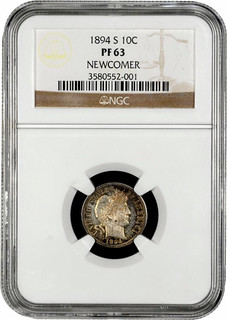 (No other case details available at this time)
(No other case details available at this time)
1. 1894-San Francisco Barber Dime. It had received a grade number of NGC PF63 and had a serial number of 3580552001. Estimated value of $1,225,000.00
2. 1652- Willow Tree 6 Pence. It had received a grade number of PCGS MS64 and had a serial number of 15-64-11163562 Estimated value of $472,000.00
3. 1794- Flowing Hair Dollar. It had received a grade number of PCGS XF45 and had a serial number of 6851-45-08888779. Estimated value of $379,500.00
La Plata County SO Case# S19-06050
Rare coin thefts unfortunately happen regularly, but this is the first time in a long while that such high profile, high value coins have gone missing. The 1967 robbery of Willis DuPont comes to mind, which included a Brasher doubloon and two 1804 dollars. Stay tuned to the numismatic media this week as more details emerge. -Editor
To vist the Numismatic Crime Information Center web site, see:
http://www.numismaticcrimes.org/
To read earlier E-Sylum articles, see:
TRACKING THE DU PONT COINS
(https://www.coinbooks.org/esylum_v07n13a07.html)
ARTICLE: THE GREAT DUPONT COIN HEIST
(https://www.coinbooks.org/esylum_v12n02a25.html)
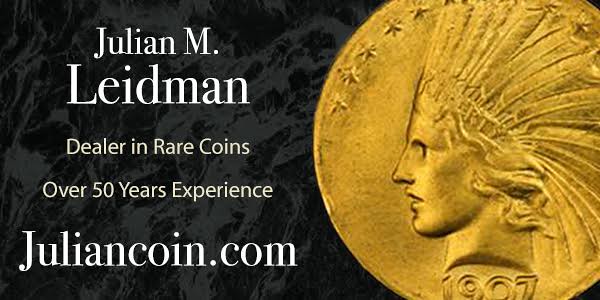
THE FOGG MUSEUM COIN HEIST
John Kraljevich forwarded a link to this podcast about the 1973 Fogg Museum coin heist. The page has links to a couple dozen articles on the event and its aftermath. -Editor
It's probably a familiar tale… Late at night, after the museum is closed, a man talks the guard into unlocking the door. Once inside, he pulls out a gun, and within seconds, the guard is tied up and blindfolded, while a gang roams through the museum, picking out rare masterpieces. By the time the guard gets himself free and calls the police, the gang has made off with millions of dollars in stolen artworks, in a case considered the largest art heist in US history. Yes, the tale may sound familiar, but we're not talking about the Isabella Stewart Gardner Museum case, we're talking about a different art heist, one that was carried out 17 years earlier and across the river in Cambridge. This is the story of the Fogg Museum coin heist.
To listen to the complete podcast, see:
The Museum Heist (episode 126)
(http://www.hubhistory.com/episodes/the-museum-heist-episode-126/)
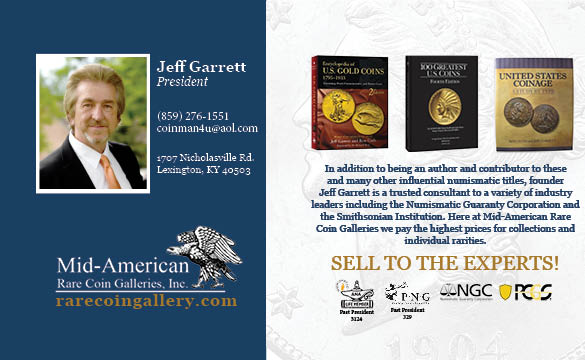
ROMAN MILITARY PAY
Mike Marotta forwarded this item linked from Task & Purpose, a blog for and about the the US military. Thanks! -Editor

A payslip belonging to a Roman auxiliary soldier, posted on Twitter earlier this month by archaeologist Joanne Ball, shows that the imperial grunt was left penniless immediately after getting paid once the military recouped expenses for food, equipment, clothes, and the like.
According to a translation available in the Database of Military Inscriptions and Papyri of Early Roman Palestine, this payslip belonged to Gaius Messius, a Roman auxiliary soldier who likely served in Masada, Israel between 72 and 75 CE.
The document was translated using the excavation reports, Christopher B. Zeichmann, the editor for the database, told Task & Purpose via email.
The receipt itself shows just how much of Gaius' hard-earned denarii, an ancient Roman currency, went back to the military. Here's the rough translation:
According to a translation available in the Database of Military Inscriptions and Papyri of Early Roman Palestine, this payslip belonged to Gaius Messius, a Roman auxiliary soldier who likely served in Masada, Israel between 72 and 75 CE.
The document was translated using the excavation reports, Christopher B. Zeichmann, the editor for the database, told Task & Purpose via email.
The receipt itself shows just how much of Gaius' hard-earned denarii, an ancient Roman currency, went back to the military. Here's the rough translation:
Let's do a quick tally of that pay slip:
• 16 denarii for "barley money."
• 20 denarii for "food expenses."
• 5 denarii for "boots."
• 2 denarii for "leather strappings."
• 7 denarii for a "linen tunic."
That comes out to 50 denarii — leaving Gaius flat broke immediately after payday.
To read the complete article, see:
This Roman soldier's 1,900-year-old payslip confirms the green weenie is immortal
(https://taskandpurpose.com/roman-soldier-payslip-green-weenie)
To read the original article, see:
§22 Gaius Messius Son of Gaius
(https://armyofromanpalestine.com/0022)
To visit the Database of Military Inscriptions and Papyri of Early Roman Palestine homepage, see:
https://armyofromanpalestine.com/
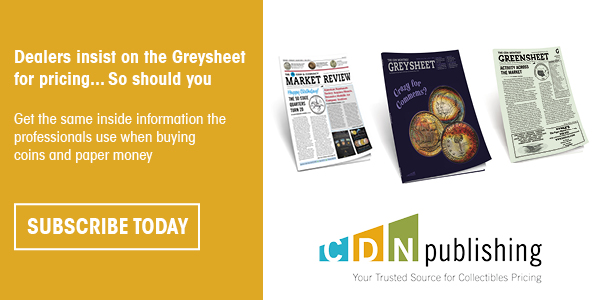
SELINA MARTIN SUFFRAGETTE HUNGER STRIKE MEDAL
This February 22, 2019 Nottingham Post article discusses another British suffragette medal recently sold at auction. -Editor
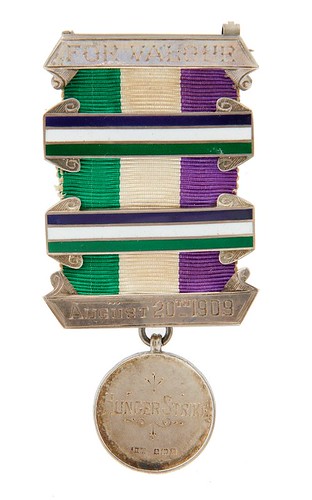 Those jailed for what are deemed to be political offences can expect to fare much worse than common criminals, even murderers or rapists. The reason is because they have offended society, whereas those classed as political prisoners have challenged the governance of a state, whether that is a democracy or a dictatorship.
Those jailed for what are deemed to be political offences can expect to fare much worse than common criminals, even murderers or rapists. The reason is because they have offended society, whereas those classed as political prisoners have challenged the governance of a state, whether that is a democracy or a dictatorship.
So it was with the suffragettes. Very few – less than 100 – were prepared to pay an extraordinarily heavy price for their principles. They endured police brutality and violent force-feeding in prison which amounted to torture. For many the physical damage and certainly the painful recollection of it was lifelong.
Never before have I handled the famous Medal for Valour of Emmeline and Christabel Pankhurst's Women's Social and Political Union. Next month Mellors & Kirk will sell that awarded to the militant suffragette Selina Martin (1882-1972).
None of the medals are ‘ordinary' in the sense that only extraordinary events merited it, but even so Selina's story is truly amazing.
The medal is engraved with her name and the dates of the occasions in 1909 when she was ‘ FED BY FORCE' in prison. It is struck in silver and was hallmarked at Birmingham in 1909.
Selina was born at Ulverston in Lancashire but when young her parents moved to Lancaster where her father opened a secondhand book shop.
With the medal, which is being sold by a family member, is a major archive of letters from Christabel Pankhurst and other prominent figures in the movement, letters Selina wrote from prison, another suffragette's letter that was smuggled out of the prison and a notorious letter to her father from the Prison Governor of Walton Jail in Liverpool.

A March 29, 2019 article published the results of the sale. -Editor
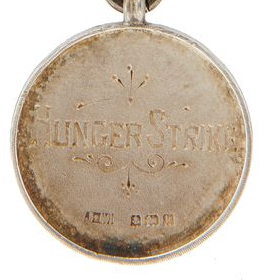 Best of all was the hunger striker's medal of suffragette Selina Martin (1882-1972) awarded by Emmeline and Christabel Pankhurst's Women's Social and Political Union in 1909. It sold for £27,000.
Best of all was the hunger striker's medal of suffragette Selina Martin (1882-1972) awarded by Emmeline and Christabel Pankhurst's Women's Social and Political Union in 1909. It sold for £27,000.
Having been the centrepiece of the recent exhibition Represent! Voices 100 Years On at the People's History Museum, the Manchester museum requested a delay to Crowdfund an appeal for its purchase.
It was not to be. Instead this highly important object, with a mini archive of letters and documents, was bought by a benefactor of the National Gallery of Victoria, Australia.
As a numismatist, 1909 doesn't seem like all that long ago. But it was only about 50 years before I was born, and I'm older than that now. My maternal grandmother was born in that year. I can't imagine a world where women didn't have the vote, yet it was made possible by the efforts and sufferings of women like Selina Martin. One generation's troublemakers can become future generations' heroes. This USA Today has a nice timeline of worldwide women's suffrage. -Editor
To read the complete article, see:
Voting rights for women: How countries stack up
(https://www.usatoday.com/story/news/2018/02/05/voting-rights-women-how-countries-stack-up/306238002/)
To read the complete articles, see:
(https://www.nottinghampost.com/news/news-opinion/rare-suffragette-medal-expected-fetch-2566676)
https://www.nottinghampost.com/news/news-opinion/suffragette-medal-sold-27000-sadly-2688667
(https://www.nottinghampost.com/news/news-opinion/suffragette-medal-sold-27000-sadly-2688667)
To read earlier E-Sylum articles, see:
A SUFFRAGETTE SOCIETY MEDAL
(https://www.coinbooks.org/esylum_v18n10a27.html)
1912 WOMEN'S HUNGER STRIKE MEDAL
(https://www.coinbooks.org/v21/esylum_v21n06a35.html)
1912 SUFFRAGETTE HUNGER STRIKE MEDAL
(https://www.coinbooks.org/v21/esylum_v21n43a22.html)

LONDON BRIDGE DOGS WIN PDSA ORDER OF MERIT
Dogs deployed in the 2017 London Bridge terror attacks have received PDSA Order of Merit medals. -Editor
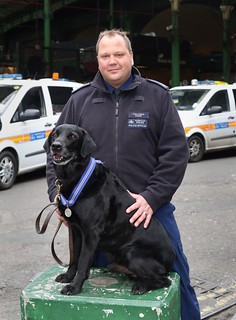 Unsung heroes of the 2017 London Bridge terror attacks have been honoured almost two years on from the atrocities.
Unsung heroes of the 2017 London Bridge terror attacks have been honoured almost two years on from the atrocities.
The PDSA has honoured dogs from the Met and British Transport Police which were involved in checking the fake suicide vests of the three London Bridge attackers after they were shot dead by police.
Along with their handlers they were involved in checking dozens of buildings for explosives as officers worked to ensure the scenes were safe.
Now they have been rewarded with the PDSA's Order of Merit recognising their work.
Four dogs were also used to search for potential devices among the chaos on the bridge.
In total, 19 dogs were used in the aftermath of the two terror attacks and seven dogs were chosen by ballot to receive the PDSA awards.
A PDSA spokeswoman said: “Throughout the incident the teams worked with the knowledge that potential further danger remained all around them, but put the safety of the public ahead of their own as they tirelessly continued their work."

To read the complete article, see:
Good boys! Hero police dogs given 'canine OBEs' for bravery in 2017 terror attacks
(https://news.yahoo.com/hero-police-dogs-awarded-canine-obes-bravery-2017-terror-attacks-152918268.html)
Note that the PDSA Order of Merit is not the same as the PDSA' Dickin Medal, which has only been awarded by the People's Dispensary for Sick Animals 71 times since 1943. The PDSA Order of Merit was created in 2014 to recognize "animals that display outstanding devotion to their owner or wider society, above and beyond normal companionship". To date it has been awarded to 10 police horses and 10 dogs. -Editor
For more information, see:
PDSA Order of Merit
(https://www.pdsa.org.uk/what-we-do/animal-awards-programme/pdsa-order-of-merit)
CANADA'S VERTICAL NOTE THAT ALMOST WAS
Canada's first vertical banknote, the Viola Desmond $10 bill entered circulation last year, but it wasn't the first time the Bank of Canada considered that format. Here's an excerpt from a blog post by Graham Iddon, of the Bank of Canada Museum. -Editor
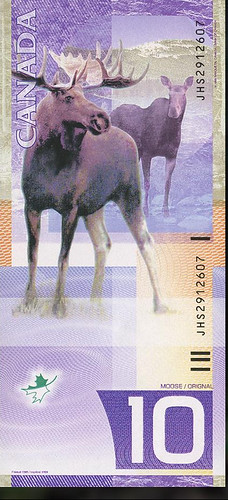 In 1997, the Bank of Canada launched public consultations to find out what Canadians felt best represented them as a people and Canada as a place. Is it a person? A place? An animal? This was the first time Canadians were consulted on what appeared on their money. More than 4,000 people from a broad array of cultures and social groups provided their opinions. There were lots of calls for beavers and Mounties, of course. But participants also talked about Rocher Percé in Quebec, Confederation, Nellie McClung, personal freedoms, hockey, Louis Riel, peacekeepers, insulin—things they thought symbolized Canada both at home and for other nations.
In 1997, the Bank of Canada launched public consultations to find out what Canadians felt best represented them as a people and Canada as a place. Is it a person? A place? An animal? This was the first time Canadians were consulted on what appeared on their money. More than 4,000 people from a broad array of cultures and social groups provided their opinions. There were lots of calls for beavers and Mounties, of course. But participants also talked about Rocher Percé in Quebec, Confederation, Nellie McClung, personal freedoms, hockey, Louis Riel, peacekeepers, insulin—things they thought symbolized Canada both at home and for other nations.
Eventually, broad Canadian themes emerged that could be used to lay the foundation for a new note series: diversity, freedom, nature, history, activities, inventions and people. This last one ranged from individual achievers to generic traditional working types, such as the lumberjack or the fur trapper.
Every aspect of a new bank note goes through sometimes dozens of versions before a final design is chosen. Even the themes are works in progress.
The first theme tentatively settled upon for the new series was wildlife. After consulting with eminent naturalists, a number of animals were proposed—animals that were strongly associated with Canada, yet didn't have any nasty, human-eating reputations (grizzlies: big and scary, otters: cute and fun).
In October 1998, the design and thematic criteria were handed off to the security printing firms. Their design teams went to work and came back with a surprising result: vertical notes.
Designed by a team headed by Canadian Bank Note Company's Jorge Peral, the set proposed was a complete departure from anything before seen in Canada. Though freshly modern, the fronts were essentially traditional bank note patterns. The backs of the notes, meanwhile, were anything but. Vertical notes had occasionally popped up in Europe, but on this side of the Atlantic, these proposed notes were indeed radical.
But these notes were not to be. In the end, a horizontal format was chosen, and the wildlife theme was abandoned for a very different approach to Canadian identity. However, the face designs of Peral's proposal were retained and further refined for the future series.
To read the complete article, see:
THE VERTICAL NOTE THAT ALMOST WAS
(https://www.bankofcanadamuseum.ca/2019/03/the-vertical-note-that-almost-was/)

IS CRYPTOCURRENCY REALLY A NEW IDEA?
Arthur Shippee forwarded this Yale Insights article on cryptocurrency. Thanks. here's an excerpt. -Editor
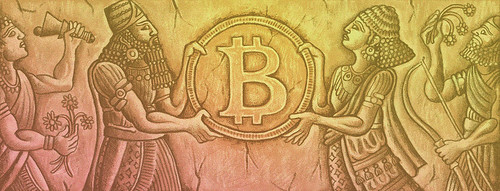
Imagine going on vacation if you had to barter along the way. Imagine taking a 401k distribution in barley. “Money is the most universal and most efficient system of mutual trust ever devised," writes historian Yuval Noah Harari. “Even people who do not believe in the same god or obey the same king are more than willing to use the same money." Yet, whether it's diamonds or gold, euros, yuan, or dollars, none have any inherent value; they can't be used as food or shelter. As Harari puts it, “Money isn't a material reality—it is a mental construct."
Societies need to store and trade value. The units of exchange, institutional supports, and technologies involved have changed over time, but whether Sumerian silas of grain or the Bitcoins accepted in hipster coffee shops, currencies only exist if people believe they have value.
Yale Insights talked with William N. Goetzmann, the Edwin J. Beinecke Professor of Finance and Management Studies and director of the International Center for Finance at the Yale School of Management, about how financial history informs our understanding of how cryptocurrencies are reimagining money.
Q: There's a great deal of hype around cryptocurrencies. Do we know how much impact they will actually have? Cryptocurrency is a speculative instrument at present. The news that we hear is all about high prices being made or low prices being made, people becoming millionaires, and people losing their Bitcoin code. It's something that catches a lot of attention but is not fundamental to the economy.
Q: What makes a currency successful?
There are all sorts of theories, but we don't quite understand what makes a currency work and what makes it really liquid. You can create all sorts of currencies but getting people to spend them and to accept them almost requires a kind of magic. The United States makes dollar coins and two-dollar bills. Nobody spends them. Why not? There's really no good explanation. They just don't have liquidity.
When the government thinks about revising the currency, they're cautious about disrupting people's reliance on doing things the way they've always done them. There are good reasons to consider getting rid of the penny but doing that would involve risk. When you're holding a physical penny, you trust that the dollar bill is worth 100 of them. Getting rid of the penny risks interrupting an institution that's worked really well, particularly for the United States.
Q: Can financial history help inform our understanding of cryptocurrency?
In ancient times, some of the money actually resembled today's cryptocurrency in the sense that it was all based on accounts, a ledger. There's no physical Bitcoin; you can buy, sell, and trade Bitcoin with other people, but it's really an accounting transaction more than anything else.
Before coins were invented, value was transferred through a system of accounts. If you and I lived in the same city, you're a baker and I make pottery—a loaf of bread is one shekel of silver; a pot is three shekels—when we would trade with each other, we were not using actual pieces of silver. We were creating credits and debits in a ledger. That's kind of the way Bitcoin is working now; there's no physical transfer.
The innovation in ancient times was the creation of metal coins that broke the reliance on an accounting system. Coins had no history. They were completely anonymous. Once I paid you, nobody knows what happened to that coin. You could use it for something completely different. Bitcoin today actually keeps a history in the blockchain, which is a distributed ledger that exists in no single place but is shared across a lot of participants.
In a sense, we're going back to the time before we had anonymous money, transferrable by physical processes. That is exciting because each method of storing and transferring value solves different kinds of problems.
To read the complete article, see:
Is Cryptocurrency Really a New Idea?
(https://insights.som.yale.edu/insights/is-cryptocurrency-really-new-idea)
THE VIRGINIA CITY PONDEROSA SALOON
The Atlas Obscura article describes an interesting Nevada tourist attraction numismatists might enjoy. -Editor
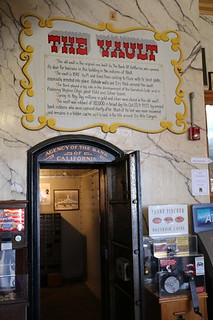 A fully-functional saloon in Virginia City, Nevada contains an 1860's bank vault and underground mine. The beloved watering hole has been offering tours of the mine shaft since the 1900s.
A fully-functional saloon in Virginia City, Nevada contains an 1860's bank vault and underground mine. The beloved watering hole has been offering tours of the mine shaft since the 1900s.
Virginia City, Nevada used to be a heavy mining town, and was pocked with tunnels dug by voracious miners hunting for silver and gold. The Best & Belcher mine was not profitable in the gold rush of the 1800s, but became profitable 100 years later in an entirely different way. The owners of the Ponderosa Saloon realized that the mine shaft of the Best & Belcher mine was only a short way away from their bar, so they dug a tunnel to the abandoned mine shaft and began offering tours.
The saloon also features an old walk-in bank vault, and the now 150-year-old establishment offers up tours of both the vault and the mine. The 25-minute tour of the mine guides you through the shaft and the more than 300 pieces of vintage mining equipment on display. After the tour, you can grab a cold drink and a hot dog from the restaurant above.
To read the complete article, see:
Ponderosa Saloon
(https://www.atlasobscura.com/places/ponderosa-saloon)
LOOSE CHANGE: MARCH 31, 2019
Here are some additional items I came across in the media this week that may be of interest. -Editor
More on the Grouville Hoard
This article from ITV News has another image of the monster hoard of Celtic coins and jewellery from Jersey. What painstaking convervation work! -Editor
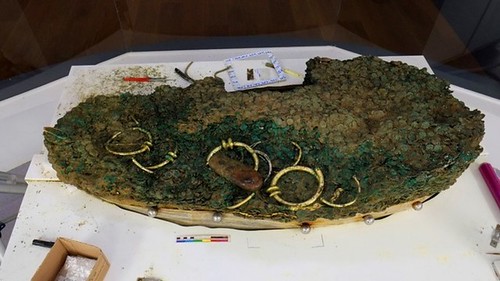
To read the complete article, see:
Jersey coin hoard now on show at La Hougue Bie
(https://www.itv.com/news/channel/2019-03-29/jersey-coin-hoard-on-show-at-la-hougue-bie/)
To read the earlier E-Sylum article, see:
JERSEY GROUVILLE HOARD WAS TWO COLLECTIONS
(https://www.coinbooks.org/v22/esylum_v22n12a24.html)
BEP To Build New D.C. Facility
Arthur Friedberg reported in Coin World March 25, 2019 that the U.S. Bureau of Engraving and Printing has been given the go-ahead to construct a new printing facility in the Washington, D.C. region. See the complete article for full details along with a history of BEP facilities through the years. -Editor
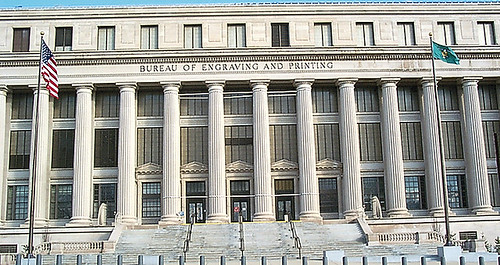
The existing facility would be renovated to enable the Treasury department to consolidate office space. Would the engraving staff stay or move? What about the small exhibit space and gift shop? Would the new facility offer tours? It might be harder to attract visitors to a suburban location, but this could be an opportunity to create new spaces for the BEP's paper money collection and archives. -Editor
To read the complete article, see:
New BEP paper money factory gets legislative go-ahead
(https://www.coinworld.com/news/paper-money/2019/03/new-bep-plant-greenlighted.all.html)
Malawi Brassiere Money
The March 26, 2019 News & Notes from the Society of Paper Money Collectors alerted me to this story from Malawi about a controversy over where some women store their banknotes. -Editor
“I have felt bad receiving bank notes from my female customers' bras. Receiving it has only been justified with the fact that I come here to make money otherwise it is embarrassing and women have to stop that act," he tells me.
“The bank has an ongoing programme on sensitization of members of the public on currency handling malpractices which include keeping currency notes in bras and other damp places. One of the reasons is indeed the spread of diseases apart from the reduction of the life span of the note. Every damp note is a home of bacteria and other micro-organisms which may transmit diseases. It is indeed our responsibility to provide clean notes at all times and this can only be achieved with the cooperation of the general public," he said in an email response on Tuesday.
To read the complete article, see:
Cash from the bra: Malawian women not left out
(https://malawi24.com/2019/03/21/cash-from-the-bra-malawian-women-not-left-out/)


